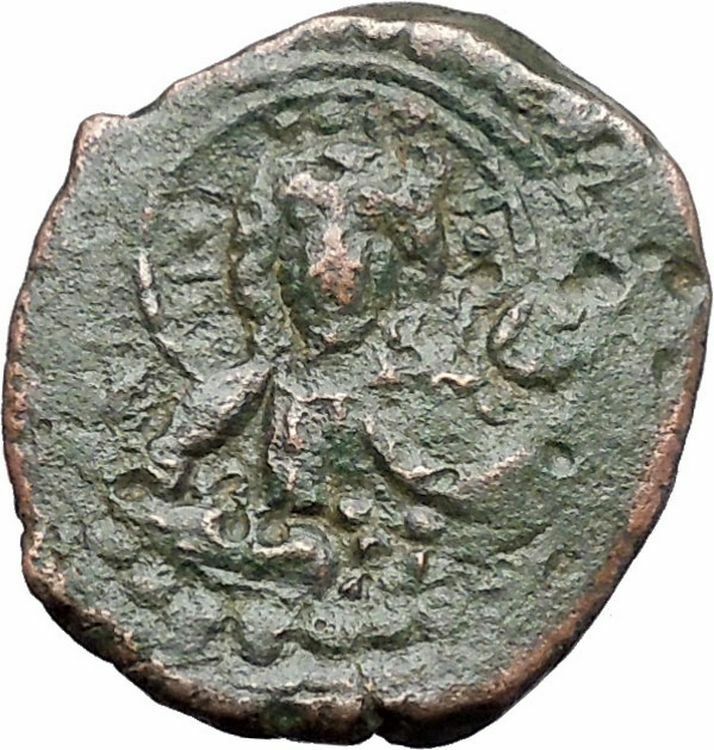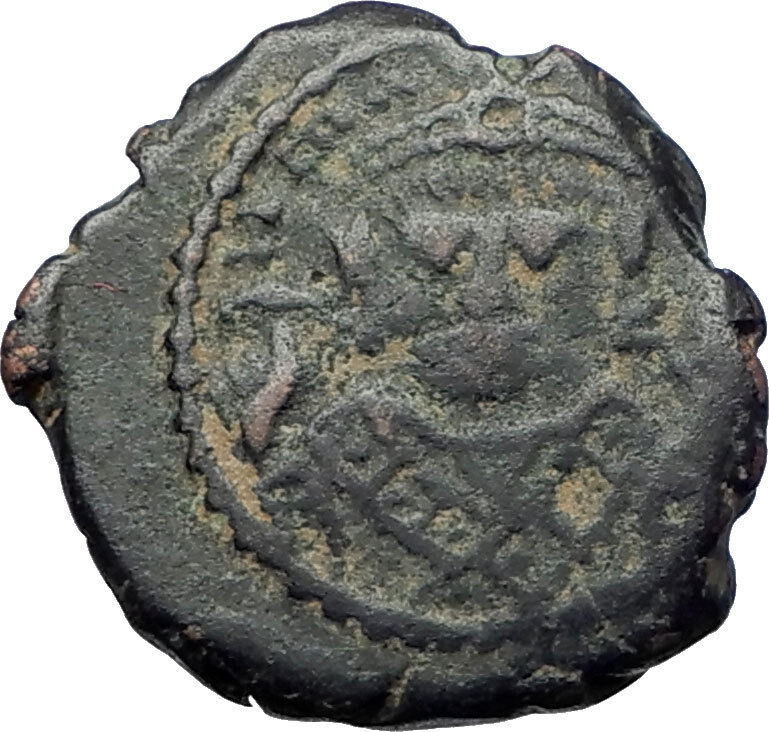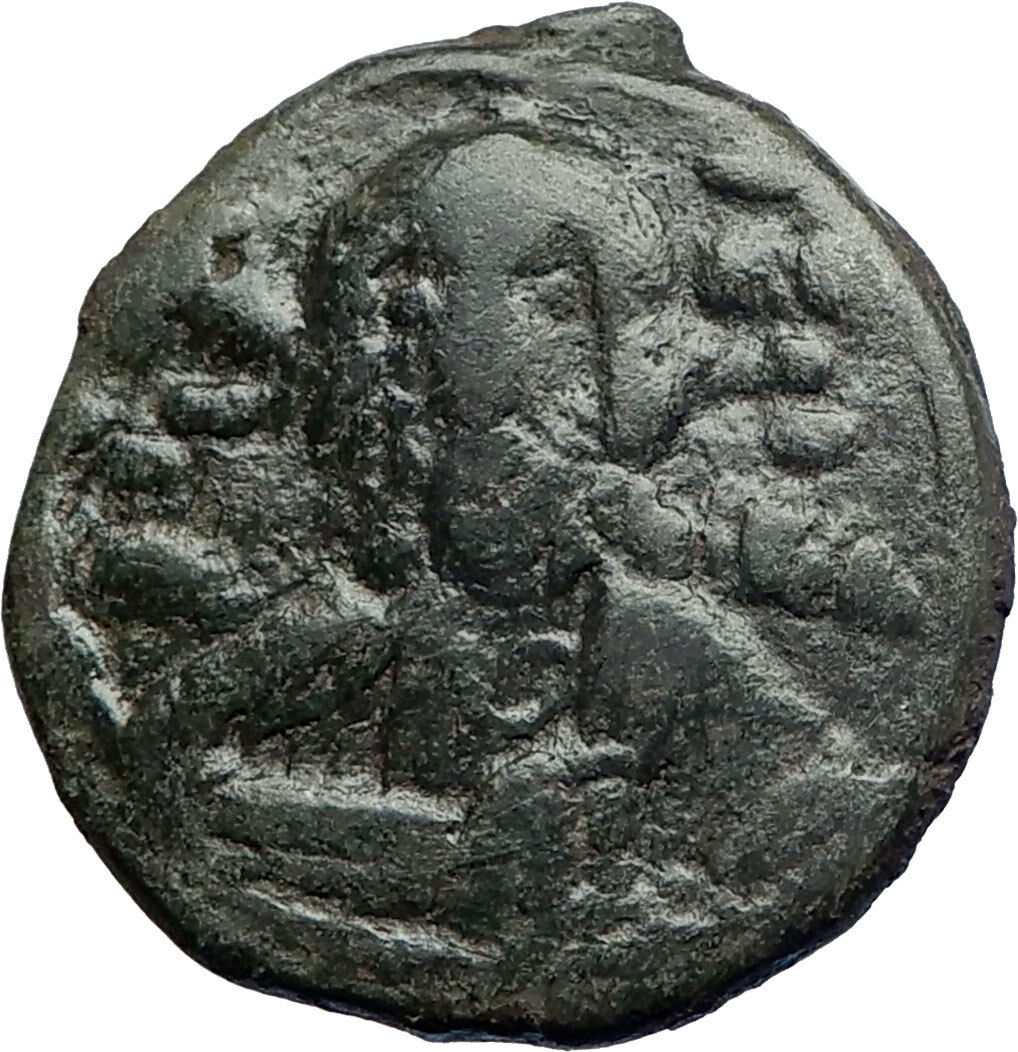|
Byzantine Empire
Anonymous Class
C
Bronze Follis 30mm (11.41 grams)
Struck during the reign of
Michael IV
1034-1041 A.D.
Reference: Sear 1825
+ЄMMANOVHΛ – Three-quarter length figure of
Christ
Antiphonetes standing facing,
wearing
nimbus crown, pallium and colobium, and raising right hand in
benediction;
in left hand, book
of
Gospels; in field to left, IC; to right, XC.
Jeweled cross
cross
, with pellet at each extremity; in the angles, IC -XC / NI – KA
(“May Jesus Christ Conquer”).
For more than a century, the production of Follis denomination Byzantine coins
had religious Christian motifs which included included
Jesus Christ, and even Virgin Mary. These coins were designed to honor Christ
and recognize the subservient role of the Byzantine emperor, with many of the
reverse inscriptions translating to “Jesus Christ King of Kings” and “May Jesus
Christ Conquer”. The Follis denomination coins
were the largest bronze denomination coins issued by the Byzantine empire, and
their large size, along with the Christian motif make them a popular coin type
for collectors. This series ran from the period of Byzantine
emperors John I (969-976 A.D.) to Alexius I (1081-1118 A.D.). The accepted
classification was originally devised by Miss Margaret Thompson with her study
of these types of coins. World famous numismatic
author, David R. Sear adopted this classification system for his book entitled,
Byzantine Coins and Their Values. The references about this coin site Mr. Sear’s
book by the number that they appear in that work. The class types of coins
included
Class A1,
Class A2,
Class B,
Class C,
Class D,
Class E,
Class F,
Class G,
Class H,
Class I,
Class J,
Class K. Read more and see examples of these coins by reading the
JESUS CHRIST
Anonymous Class A-N Byzantine Follis Coins Reference.
Click here to see all the Jesus Christ Anonymous Follis coins for sale.
Click here to see all coins bearing Jesus Christ or related available for sale.
You are bidding on the exact
item pictured, provided with a Certificate of Authenticity and Lifetime
Guarantee of Authenticity.
Jesus of Nazareth (c. 5 BC/BCE – c. 30 AD/CE), also
referred to as Jesus Christ or simply Jesus, is the central figure
of
Christianity. Most
Christian denominations
venerate him as
God the
Son
incarnated
and believe that he
rose from the dead
after being
crucified
.
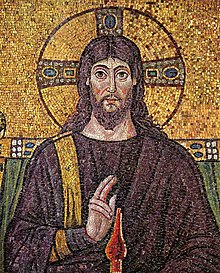
The
principal sources of information regarding Jesus are the four
canonical gospels, and most
critical scholars
find them, at least the
Synoptic Gospels, useful for reconstructing Jesus’ life and
teachings. Some scholars believe apocryphal texts such as the
Gospel of Thomas and the
Gospel according to the Hebrews
are also
relevant
.
Most critical historians agree that Jesus was a
Jew
who was regarded as a teacher and
healer
, that he
was baptized
by
John the Baptist, and
was crucified
in
Jerusalem
on the orders of the
Roman Prefect
Judaea,
Pontius Pilate, on the charge of
sedition
against the Roman Empire
. Critical Biblical scholars and
historians have offered competing descriptions of Jesus as a self-described
Messiah,
as the leader of an apocalyptic movement, as an itinerant sage, as a charismatic
healer, and as the founder of an independent religious movement. Most
contemporary scholars of the
Historical Jesus consider him to have been an independent,
charismatic founder of a Jewish restoration movement, anticipating an imminent
apocalypse. Other prominent scholars, however, contend that Jesus’ “Kingdom
of God” meant radical personal and social transformation instead of a
future apocalypse.
Christians traditionally believe that Jesus was
born of a virgin
:529–32
performed
miracles
,:358–59
founded
the Church
,
rose from the dead
, and
ascended
into
heaven,:616–20
from which he
will return
.:1091–109
Most Christian scholars today present Jesus as the awaited Messiah promised in
the
Old Testament and as God, arguing that he fulfilled many Messianic
prophecies of the Old Testament
. The majority of Christians
worship Jesus as the incarnation of God the Son, one of three divine persons of
a reject Trinitarianism
Trinity, wholly or partly,
believing it to be non-scriptural.
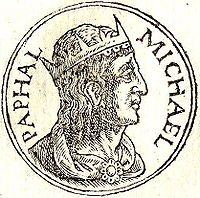 Michael Michael
IV the Paphlagonian (Greek:
Mikhaēl IV Paphlagōn), (1010 – December 10, 1041), was
Eastern Roman Emperor
from April 11, 1034 to December 10, 1041. He owed his
elevation to Empress
Zoe
, daughter of Emperor
Constantine VIII
and wife of
Romanos III
Argyros.
Michael came from a family of
Paphlagonian
peasants, one of whom, the
parakoimomenos
John the Eunuch
had come to preside over the woman’s quarters at the imperial palace. John
brought his younger brothers into the court and there the empress Zoe became
enamoured of Michael, who became her chamberlain. Zoe and Michael decided to use
a slow poison to kill Zoe’s husband Romanos III. However, becoming impatient
with the poison, they drowned him and Zoe immediately married Michael, on April
11, 1034. Michael IV was also proclaimed emperor and reigned together with Zoe
until his death in 1041.
Michael IV was handsome, clever, and generous, but he was uneducated and
suffered from epileptic
fits. Therefore he left the government in the hands of his brother
John, who had already become an influential minister of Constantine VIII and
Romanos III. John’s reforms of the army and financial system revived for a while
the strength of the Empire, which held its own successfully against its foreign
enemies. But the increase in taxation caused discontent among both nobles and
commoners. John’s monopoly of the government led to several failed conspiracies
against him in 1034, 1037, 1038, and 1040 one of which was led by the Empress
Zoe herself. The last conspiracy involved the patrician
Michael Keroularios
, who became a monk to save his life and was later
elected as
patriarch of Constantinople
.
On the eastern frontier the important fortress of
Edessa
was relieved after a prolonged siege. On the western front the
Muslims
were almost driven out of
Sicily
by
George Maniakes
(who campaigned there between 1037 and 1040). Maniakes fell
out with his Lombard allies, however, and lost the support of the Lombards and
Normans. After the recall of Maniakes most of the Sicilian conquests were lost
(1041), and a subsequent expedition against the
Italian
Normans
suffered several defeats.
In the north the Serbs
revolted successfully in 1040, as did the
Bulgarians
in western Bulgaria and
Macedonia
in the same year. This revolt was partly caused by the heavy
taxation in coin imposed on Bulgaria at the time, but it aimed at the
restoration of the Bulgarian state under the leadership of
Peter Delyan
. Although Michael IV was chased out of the vicinity of
Thessalonica
by the rebels, he returned with an army of 40,000 men in 1041
assisted by Norse mercenaries including the future King
Harald III of Norway
. The military success of the Romans was aided by
internal dissention among the Bulgarians and eventually their leaders were
defeated and captured. Michael IV returned to Constantinople in triumph but he
was now decrepit with illness and died on December 10, 1041.
|
Jesus |
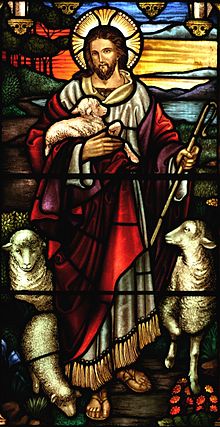
Jesus depicted as
the Good
Shepherd
(stained
glass at St
John’s Ashfield) |
| Born |
7–2 BC
Judea, Roman
Empire |
| Died |
30–36 AD
Judea, Roman Empire |
Cause of
death |
Crucifixion |
| Home town |
Nazareth, Galilee |
Jesus (//; Greek: Ἰησοῦς Iesous;
7–2 BC to 30–36 AD), also referred to as Jesus
of Nazareth, is the central figure of Christianity,
whom the teachings of most Christian
denominations hold to be the Son
of God. Christians believe Jesus
to be the awaited Messiah of
the Old
Testament and refer to him as Jesus
Christ or simply Christ, a
name that is also used by non-Christians.
Virtually all modern scholars of antiquity agree that a historical
Jesus existed, although there
is little agreement on the reliability
of the gospel narratives and
their assertions of his divinity. Most
scholars agree that Jesus was a Jewishteacher
from Galilee, was
baptized by John
the Baptist, and was
crucified in Jerusalem on
the orders of the Roman
prefect, Pontius
Pilate. Scholars have constructed
various portraits of the historical
Jesus, which often depict him as having one or more of the following roles:
the leader of an apocalyptic movement,
Messiah, a charismatic healer, a sage and philosopher, or an egalitarian social
reformer. Scholars have
correlated the New
Testament accounts with
non-Christian historical records to arrive at an estimated chronology
of Jesus’ life.
Most Christians believe that Jesus was conceived by the Holy
Spirit, born
of a virgin, performed miracles,
founded the
Church, died by crucifixion as a sacrifice to achieve atonement, rose
from the dead, and ascended into heaven,
from which hewill
return. The majority of
Christians worship Jesus as the incarnation of God
the Son, who is the Second Person of the Holy
Trinity. A few Christian groups reject
Trinitarianism, wholly or partly, as non-scriptural.
In Islam, Jesus (commonly transliterated as Isa)
is considered one of God’s important prophets. To
Muslims, Jesus is a bringer
of scripture and the child of a
virgin birth, but neither divine nor the victim of crucifixion. Judaism rejects the
belief that Jesus was the awaited Messiah, arguing that he did not fulfill the Messianic
prophecies in the Tanakh. Bahá’í scripture
almost never refers to Jesus as the Messiah, but calls him a Manifestation
of God.
Etymology of names
A typical Jew in Jesus’ time had only one name, sometimes supplemented with the
father’s name or the individual’s hometown. Thus,
in the Christian
Bible, Jesus is referred to as “Jesus of Nazareth” (Matthew
26:71), “Joseph’s son” (Luke
4:12), and “Jesus of Nazareth, the son of Joseph” (John
1:45). The name Jesus,
which occurs in a number of languages, is derived from the Latin Iesus,
a transliteration of
the Greek Ἰησοῦς (Iesous). The
Greek form is a rendition of the Aramaic ישוע
(Yeshua), which is derived from the Hebrew יהושע
(Yehoshua). The nameYeshua appears
to have been in use in Judea at the time of the birth of Jesus. The
first-century works of historian Flavius
Josephus refer to at least twenty
different people with this name. The
etymology of Jesus’ name in the context of the New Testament is generally given
as “Yahwehsaves”,
“Yahweh will save”, or “Yahweh is salvation”.
Since early Christianity, Christians have commonly referred to Jesus as “Jesus
Christ”. The word Christ is
derived from the Greek Χριστός (Christos), which
is a translation of the Hebrew מָשִׁיחַ (Masiah),
meaning the “anointed”
and usually transliterated into English as “Messiah”. Christians
designate Jesus as Christ because they believe he is the awaited Messiah prophesied in
the Hebrew
Bible (Old Testament). In
postbiblical usage, Christ became
viewed as a name—one part of “Jesus Christ”—but originally it was a title. Since
the first century, the term “Christian” (meaning “one who owes allegiance to the
person of Christ”) is used to identify the followers of Jesus.
Chronology
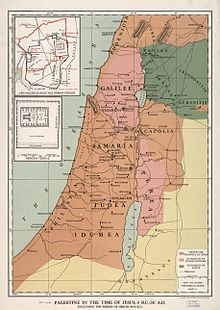
Judea and Galilee at
the time of Jesus
Most scholars agree that Jesus was a Galilean Jew who
was born around the beginning of the first century and died between 30 and 36 AD
in Judea. Amy-Jill
Levine states that the general
scholarly consensus is that Jesus was a contemporary of John
the Baptist and was crucified by
Roman governor Pontius
Pilate, who reigned from 26 to 36 AD. Most
scholars hold that Jesus lived in Galilee and Judea and did not preach or study
elsewhere.
The gospels offer several clues concerning the year of Jesus’ birth. Matthew
2:1 associates the birth of Jesus
with the reign of Herod
the Great, who died around 4 BC, and Luke
1:5 mentions that Herod was on
the throne shortly before the birth of Jesus. Luke’s
gospel also associates the birth with the Census
of Quirinius. Luke
3:23 states that Jesus was “about
thirty years of age” at the start of his ministry, which according to Acts
10:37–38 was preceded by John’s
ministry, which according to Luke
3:1–2 began in the 15th year of
Tiberius’ reign (28 or 29 AD). By
collating the gospel accounts with historical data, along with using various
other methods, most scholars arrive a date of birth between 6 and 4 BC, but
some propose a wider range between 7 and 2 BC.
The years of Jesus’ ministry have been estimated using several different
approaches. One approach applies the
reference in Luke
3:1–2, Acts
10:37–38 and the dates of
Tiberius’ reign, which are well known. This gives a date of around 28–29 AD for
the start of Jesus’ ministry. Another
approach uses the statement about the temple in John
2:13–20, which states that the temple
in Jerusalem was in its 46th year
of construction at the start of Jesus’ ministry, together withJosephus’
statement that the temple’s
reconstruction was started by Herod in the 18th year of his reign, to estimate a
date around 27–29 AD. Another method
uses the date of the death
of John the Baptist and the
marriage of Herod Antipas toHerodias,
based on the writings of Josephus, and correlates it with Matthew
14:4 and Mark
6:18. Given that most scholars
date the marriage of Herod and Herodias as AD 28–35, this yields a date about
28–29 AD.
A number of approaches have been used to estimate the year of the Crucifixion of
Jesus, leading most scholars to agree that he died between 30 and 36 AD. The
gospels state that the event occurred during the prefecture of Pilate, who was
the Roman governor of Judea from 26 AD until 36 AD. Scholars
believe the Crucifixion occurred before the conversion
of Paul, which is estimated at around 33–36 AD. Astronomers
since Isaac
Newton have tried to estimate the
precise date of the Crucifixion, the most widely accepted dates being April 7,
30 AD, and April 3, 33 AD (both Julian).
Life and
teachings in the New Testament
The four canonical
gospels (Matthew, Mark, Luke,
and John)
are the main sources for the biography of Jesus, but other parts of the New
Testament, such as the Pauline
epistles, which were probably written decades before the gospels, also
include references to key episodes in his life, such as the Last
Supper in 1
Corinthians 11:23–26. The Acts
of the Apostles (10:37–38 and 19:4)
refers to the early ministry of Jesus and its anticipation by John the Baptist. Acts
1:1–11 says more about the Ascension
of Jesus (also mentioned in 1
Timothy 3:16) than the canonical gospels do.
Canonical gospel
accounts
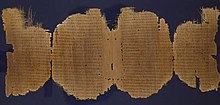
A 3rd-century Greek papyrus of Luke
Not everything contained in the New Testament gospels is considered to be
historically reliable. Elements whose
historical authenticity are disputed include the two accounts of the Nativity,
as well as the Resurrection and certain details about the Crucifixion. Views
on the gospels range from their being inerrant descriptions
of the life of Jesus to their
providing no historical information about his life.
Three of the four canonical gospels, Matthew, Mark, and Luke, are known as the Synoptic
Gospels, from the Greek σύν (syn “together”)
and ὄψις (opsis “view”). According
to the majority viewpoint, the Synoptic Gospels are the primary sources of
historical information about Jesus. They
are very similar in content, narrative arrangement, language and paragraph
structure. Scholars generally agree
that it is impossible to find any direct literary relationship between the
Synoptic Gospels and the Gospel of John.
In general, the authors of the New Testament showed little interest in an
absolute chronology of Jesus or in synchronizing the episodes of his life with
the secular history of the age. As
stated in John
21:25, the gospels do not claim to provide an exhaustive list of the events
in the life of Jesus. The accounts
were primarily written as theological documents in the context of early
Christianity, with timelines as a secondary consideration. One
manifestation of the gospels as theological documents rather than historical
chronicles is that they devote about one third of their text to just seven days,
namely the last week of the life of Jesus in Jerusalem, referred to as Passion
Week. Although the gospels do not
provide enough details to satisfy the demands of modern historians regarding
exact dates, it is possible to draw from them a general picture of the life
story of Jesus.
The gospel accounts sometimes differ in the ordering of the parables, miracles,
and other events. While the flow of
the some events, such as the Baptism, Transfiguration,
and Crucifixion of
Jesus, and his interactions with the Apostles, are shared among the Synoptic
Gospels, events such as the Transfiguration do not appear in John’s Gospel,
which also differs on other matters, such as the Cleansing
of the Temple. Since the second
century, attempts have been made to harmonize the
gospel accounts into a single narrative, Tatian’s Diatesseron perhaps
being the first.
The gospels include a number of discourses by Jesus on specific occasions, such
as the Sermon
on the Mount and the Farewell
Discourse. They also include over 30 parables spread throughout the
narrative, often with themes that relate to the sermons. John
14:10 stresses the importance of
the words of Jesus and attributes them to the authority of God the Father. The
gospel descriptions of Jesus’ miracles are often accompanied by records of his
teachings.
Genealogy and Nativity

“Adoration of the Shepherds” by Gerard
van Honthorst, 1622
Accounts of the genealogy and
Nativity of Jesus appear in the New Testament only in the gospels of Luke and
Matthew. Outside the New Testament, documents exist that are more or less
contemporary with Jesus and the gospels, but few shed any light on biographical
details of his life, and these two gospel accounts remain the main sources of
information on the genealogy and Nativity.
Matthew begins
his gospel with the genealogy of
Jesus, before giving an account of Jesus’ birth. He traces Jesus’ ancestry to
Abraham through David. Luke
3:22 discusses the genealogy
after describing the Baptism of Jesus, when the voice from Heaven addresses
Jesus and identifies him as the Son
of God. Luke traces Jesus’ ancestry through Adam to
God.
The Nativity is a prominent element in the Gospel of Luke, comprising over 10
percent of the text and being three times as long as Matthew’s Nativity text. Luke’s
account emphasizes events before the birth of Jesus and centers on Mary, while
Matthew’s mostly covers those after the birth and centers on Joseph. Both
accounts state that Jesus was born to Joseph and Mary,
his betrothed,
in Bethlehem,
and both support the doctrine of the virgin
birth, according to which Jesus was miraculously conceived by the Holy
Spirit in Mary’s womb when she was still a virgin.
In Luke
1:31–38 Mary learns from the
angel Gabriel that
she will conceive and bear a child called Jesus through the action of the Holy
Spirit. Following his betrothal to
Mary, Joseph is troubled (Matthew
1:19–20) because Mary is pregnant, but in the first of Joseph’s
three dreams an angel assures him
not be afraid to take Mary as his wife, because her child was conceived by the
Holy Spirit. When Mary is due to give
birth, she and Joseph travel from Nazareth to
Joseph’s ancestral home in Bethlehem to register in the census of Quirinius.
There Mary gives birth to Jesus, and as they have found no room in the inn, she
places the newborn in a manger (Luke
2:1–7). An angel
visits some shepherds and sends
them to adore
the child (Luke
2:22). After presenting Jesus at the Temple, Joseph and Mary return home to
Nazareth. In Matthew
1:1–12, wise
men or Magi from
the East bring gifts to the young Jesus as the King
of the Jews. Herod hears of Jesus’ birth and, wanting him killed, orders the murder
of young male children in Bethlehem. But an angel warns Joseph in his second
dream, and the family flees
to Egypt, later to return and settle in Nazareth.
Early life and
profession
Jesus’ childhood home is identified in the gospels of Luke and Matthew as the
town of Nazareth in Galilee. Mary’s husband Joseph appears in descriptions of
Jesus’ childhood, but no mention is made of him thereafter. The
New Testament books of Matthew, Mark, and Galatians mention
Jesus’ brothers and sisters, but the Greek word adelphos in
these verses has also been translated as “kinsman”, rather than the more usual
“brother”.
Originally written in Koine
Greek, the Gospel of Mark calls Jesus in Mark
6:3 a τέκτων (tekton),
usually understood to mean a carpenter, and Matthew
13:55 says he was the son of a tekton. Although
traditionally translated as “carpenter”, tekton is
a rather general word (from the same root that leads to “technical” and
“technology”) that could cover makers of objects in various materials, even
builders. Beyond the New Testament
accounts, the association of Jesus with woodworking is a constant in the
traditions of the first and second centuries. Justin
Martyr (d. ca. 165) wrote that
Jesus made yokes and ploughs.
Baptism and temptation

Trevisani’s depiction of the typical baptismal scene with the
sky opening and the Holy Spirit descending as a dove, 1723
Gospel accounts of the Baptism of Jesus are always preceded by information about
John the Baptist and his ministry. They
show John preaching penance and repentance for the remission of sins and
encouraging the giving of alms to
the poor (Luke
3:11) as he baptized people in the area of the River
Jordan around Perea at
about the time when Jesus began his ministry. The Gospel of John (1:28)
initially specifies “Bethany beyond the Jordan”, that is Bethabara in
Perea, and later John
3:23 refers to further baptisms
in Ænon “because
there was much water there”.
In the gospels, John had been foretelling (Luke
3:16) the arrival of someone “mightier than I”, and Paul
the Apostle also refers to this (Acts
19:4). In Matthew
3:14, on meeting Jesus, the Baptist says, “I have need to be baptized of
thee”, but Jesus persuades John to baptize him nonetheless. After
he does so and Jesus emerges from the water, the sky opens and a voice from
Heaven states, “This is my beloved Son in whom I am well pleased” (Matthew
3:17). The Holy Spirit then descends upon Jesus as a dove. In John
1:29–33, rather than a direct narrative, the Baptist bears witness to the
episode. This is one of two events
described in the gospels where a voice from Heaven calls Jesus “Son”, the other
being the Transfiguration.
After the baptism, the Synoptic Gospels describe the Temptation
of Christ, in which Jesus resisted temptations from the
devil while fasting for forty
days and nights in the Judaean
Desert. The Gospel of John omits
the Temptation and proceeds directly to the first encounter between Jesus and
two of his future disciples (John
1:35–37): on the day after the Baptism, the Baptist sees Jesus again and
calls him the Lamb
of God; two disciples of John the Baptist hear this and follow Jesus.
Ministry

A 19th-century painting depicting the Sermon on the Mount by Carl
Bloch
The gospels present John the Baptist’s ministry as the precursor of that of
Jesus. Starting with his Baptism, Jesus begins his ministry in the countryside
of Judea, near the River Jordan, when he is “about thirty years of age” (Luke
3:23). He then travels, preaches and performs miracles, eventually
completing his ministry with the Last Supper with his disciples in Jerusalem.
Scholars divide the ministry of Jesus into several stages. The Galilean ministry
begins when Jesus returns to Galilee from the Judaean Desert after rebuffing the
temptation of Satan. Jesus preaches around Galilee, and in Matthew
4:18–20, his
first disciples, who will eventually form the core of the early Church,
encounter him and begin to travel with him. This
period includes the Sermon on the Mount, one of Jesus’ major discourses. This
period also includes the Calming
the storm, Feeding
the 5000, Walking
on water, and a number of other miracles and parables. This
period ends with the Confession
of Peter and the Transfiguration.
As Jesus travels towards Jerusalem, in the Perean ministry,
he returns to the area where he was baptized, about one-third the way down from
the Sea of Galilee along the Jordan (John
10:40–42). The final
ministry in Jerusalem begins with
the Jesus’ triumphal entry into Jerusalem on Palm
Sunday. In the Synoptic Gospels,
during that week Jesus drives the money changers from the Temple and Judas
bargains to betray him. However,
John’s Gospel places the Temple incident during the early part of Jesus’
ministry, and scholars differ on whether these are one or two separate
incidents. This period culminates in
the Last Supper and the Farewell Discourse.
Teachings and preachings

Jesus cleansing a leper –
medieval mosaic from
theMonreale
Cathedral
Commentaries often discuss the teachings of Jesus in terms of his “words and
works”. The words include a number of
sermons, as well as parables that appear throughout the narrative of the
Synoptic Gospels (the Gospel of John includes no narrative parables). The works
include the miracles and other acts performed during Jesus’ ministry. Although
the canonical gospels are the major source of the teachings of Jesus, the
Pauline epistles provide some of the earliest written accounts.
The New Testament presents the teachings of Jesus not merely as his own
preaching, but as divine revelation. John the Baptist, for example, states in John
3:34: “For he whom God hath sent speaketh the words of God: for he giveth
not the Spirit by measure.” In John
7:16 Jesus says, “My teaching is
not mine, but his that sent me.” He asserts the same thing in John
14:10: “Believest thou not that I am in the Father, and the Father in me?
the words that I say unto you I speak not from myself: but the Father abiding in
me doeth his works.” In Matthew
11:27 Jesus claims divine
knowledge, stating: “no one knoweth the Son, save the Father; neither doth any
know the Father, save the Son”.
The Kingdom of God (also called the Kingdom of Heaven in Matthew) is one of the
key elements of Jesus’ teachings in the New Testament. Jesus
promises inclusion in the Kingdom for those who accept his message. He calls
people to repent their sins and to devote themselves completely to God. Jesus
tells his followers to adhere strictly to Jewish
law, although he has broken the law himself, especially regarding the Sabbath. When
asked what the greatest commandment is, Jesus replies: “Thou shalt love the Lord
thy God with all thy heart, and with all thy soul, and with all thy mind … And
a second like [unto it] is this, Thou shalt love thy neighbor as thyself” (Matthew
22:37–39). Other ethical teachings of Jesus include loving
one’s enemies, refraining from hatred and lust, and turning
the other cheek (Matthew
5:21–44).
In the gospels, the approximately thirty parables form about one third of Jesus’
recorded teachings. The parables
appear within longer sermons and at other places in the narrative. They
often contain symbolism, and usually relate the physical world to the spiritual. Common
themes in these tales include the kindness and generosity of God and the perils
of transgression. Some of his
parables, such as the Prodigal
Son (Luke
15:11–32), are relatively simple, while others, such as theGrowing
Seed (Mark
4:26–29), are more abstruse.
The gospel episodes that include descriptions of the miracles of Jesus also
often include teachings, and the miracles themselves involve an element of
teaching. Many of the miracles teach
the importance of faith. In the cleansing
of ten lepers and the raising
of Jairus’ daughter, for instance, the beneficiaries are told that their
healing was due to their faith. When
Jesus’ opponents accuse him of performing exorcisms by the power of Beelzebul,
the prince of demons, Jesus counters that he performs miracles by the “Spirit of
God” (Matthew
12:28) or “finger of God” (Luke
11:20).
Proclamation as Christ and Transfiguration
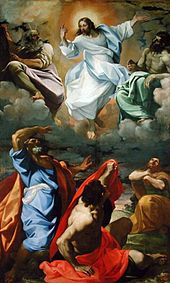
Transfiguration of Jesusdepicting him with Elijah, Mosesand
3 apostles by Carracci,
1594
At about the middle of each of the three Synoptic Gospels, two related episodes
mark a turning point in the narrative: the Confession of Peter and the
Transfiguration of Jesus. They take
place near Caesarea
Philippi, just north of the Sea
of Galilee, at the beginning of the final journey to Jerusalem that
ends in the Passion and Resurrection
of Jesus. These events mark the
beginnings of the gradual disclosure of the identity of Jesus to his disciples
and his prediction of his own suffering and death.
Peter’s Confession begins as a dialogue between Jesus and his disciples in Matthew
16:13, Mark
8:27 and Luke
9:18. Jesus asks his disciples, “who say ye that I am?” Simon Peter answers,
“Thou art the Christ, the Son of the living God” (Matthew
16:15–16). Jesus replies,
“Blessed art thou, Simon Bar-jonah: for flesh and blood hath not revealed it
unto thee, but my Father who is in heaven.” With this blessing, Jesus affirms
that the titles Peter ascribes to him are divinely revealed, thus unequivocally
declaring himself to be both Christ and the Son of God.
The account of the Transfiguration appears in Matthew
17:1–9, Mark
9:2–8, and Luke
9:28–36. Jesus takes Peter and
two other apostles up an unnamed mountain, where “he was transfigured before
them; and his face did shine as the sun, and his garments became white as the
light.” A bright cloud appears around
them, and a voice from the cloud says, “This is my beloved Son, in whom I am
well pleased; hear ye him” (Matthew
17:1–9). The Transfiguration
reaffirms that Jesus is the Son of God (as in his Baptism), and the command
“hear ye him” identifies him as God’s messenger and mouthpiece.
Final week: betrayal, arrest, trial, and death
The description of the last week of the life of Jesus (often called Passion
Week) occupies about one third of the narrative in the canonical gospels, starting
with a description of the Triumphal
entry into Jerusalem and ending
with his Crucifixion.The last week in Jerusalem is the conclusion of the journey
through Perea and Judea that Jesus began in Galilee. Just
before the entry into Jerusalem, the Gospel of John includes the Raising
of Lazarus, which increases the tension between Jesus and the authorities.
Final entry into
Jerusalem
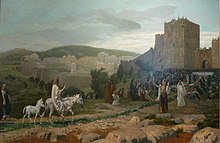
A painting of Jesus’ final entry into Jerusalem, by Jean-Léon
Gérôme in 1897
In the four canonical gospels, Jesus’ final entry into Jerusalem takes place at
the beginning of the last week of his life, a few days before the Last Supper,
marking the beginning of the Passion narrative. The
day of entry into Jerusalem is identified by Mark and John as Sunday and by
Matthew as Monday; Luke does not identify the day. After
leaving Bethany Jesus
rides a young donkey into Jerusalem. People along the way lay cloaks and small
branches of trees in front of him and sing part of Psalm
118:25–26. The cheering crowds
greeting Jesus as he enters Jerusalem add to the tension between him and the
authorities.
In the three Synoptic Gospels, entry into Jerusalem is followed by the Cleansing
of the Temple, in which Jesus expels the money changers from the temple,
accusing them of turning it into a den of thieves through their commercial
activities. This is the only account of Jesus using physical force in any of the
gospels. John
2:13–16 includes a similar
narrative much earlier, and scholars debate whether the passage refers to the
same episode. The Synoptics include a
number of well-known parables and sermons, such as the Widow’s
mite and the Second
Coming Prophecy, during the week that follows.
The Synoptics record conflicts that took place between Jesus and the Jewish
elders during Passion Week in episodes such as the Authority
of Jesus questioned and the Woes
of the Pharisees, in which Jesus criticizes their hypocrisy.
Judas Iscariot, one of the twelve
apostles, approaches the Jewish elders and strikes a bargain with them, in
which he undertakes to betray Jesus and hand him over to them for a reward of thirty
silver coins.
Last Supper
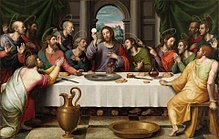
The Last Supper, depicted in this 16th-century painting by Joan de
Joanes.
The Last Supper is the final meal that Jesus shares with his twelve
apostles in Jerusalem before his
crucifixion. The Last Supper is mentioned in all four canonical gospels, and
Paul’s First
Epistle to the Corinthians (11:23–26)
also refers to it. During the meal, Jesus
predicts that one of his apostles
will betray him. Despite each
Apostle’s assertion that he would not betray him, Jesus reiterates that the
betrayer would be one of those present. Matthew
26:23–25 and John
13:26–27 specifically identify
Judas as the traitor.
In the Synoptics, Jesus takes bread, breaks it and gives it to the disciples,
saying, “This is my body which is given for you”. He then has them all drink
from a cup, saying, “This cup is the new covenant in my blood” (Luke
22:19–20). Although the Gospel of John does not include a description of the
bread-and-wine ritual during the Last Supper, most scholars agree that John
6:58–59 (the Bread
of Life Discourse) has a eucharistic character and resonates with the institution
narratives in the Synoptic
Gospels and in the Pauline writings on the Last Supper.
In all four gospels, Jesus predicts that Peter will deny knowledge of him three
times before the rooster crows
the next morning. In Luke and John,
the prediction is made during the Supper (Luke
22:34, John
22:34). In Matthew and Mark, the prediction is made after the Supper, and
Jesus also predicts that all his disciples will desert him (Matthew
26:31–34, Mark
14:27–30). The Gospel of John
provides the only account of Jesus washing his disciples’ feet before the meal. John
also includes a long sermon by Jesus, preparing his disciples (now without
Judas) for his departure. Chapters
14–17 of the Gospel of John are
known as the Farewell
Discourse and are a significant
source of Christological content.
Agony
in the Garden, betrayal and arrest
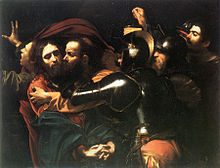
A 17th-century depiction of the kiss of Judas and the arrest of
Jesus byCaravaggio
After the Last Supper, Jesus, accompanied by his disciples, takes a walk to
pray. Matthew and Mark identify the place as the garden
of Gethsemane, while Luke identifies it as the Mount of Olives. Judas
appears in the garden, accompanied by a crowd that includes the Jewish priests
and elders and people with weapons. He kisses
Jesus to identify him to the
crowd, which then arrests
Jesus. In an attempt to stop
them, one of Jesus’ disciples uses a sword to cut off the ear a man in the
crowd. Luke states that Jesus
miraculously heals the wound, and John and Matthew report that Jesus criticizes
the violent act, enjoining his disciples not to resist his arrest. In Matthew
26:52 Jesus says, “all
they that take the sword shall perish with the sword”. After
Jesus’ arrest, his disciples go into hiding, and Peter, when questioned, thrice
denies knowing Jesus. After the third
denial, he hears the rooster crow and recalls the prediction as Jesus turns to
look at him. Peter then weeps bitterly.
Trials by the Sanhedrin, Herod and Pilate

Jesus in the upper right hand corner, his hands bound behind, is
being tried at the high priest’s house and turns to look at Peter,
in Rembrandt’s
1660 depiction ofPeter’s
denial.
After his arrest, Jesus is taken to the Sanhedrin,
a Jewish judicial body. The gospel
accounts differ on the details of the trials. In Matthew
26:57, Mark
14:53 and Luke
22:54, Jesus is taken to the high priest’s house, where he is mocked and
beaten that night. Early next morning, the chief priests and scribes lead Jesus
away into their council. John
18:12–14 states that Jesus is
first taken to Annas,
the father-in-law of Caiaphas, and then to Caiaphas. All
four gospels report the Denial
of Peter, where Peter denies knowing Jesus three times before the rooster
crows, as predicted by Jesus.
During the trials Jesus speaks very little, mounts no defense and gives very
infrequent and indirect answers to the questions of the priests, prompting an
officer to slap him. In Matthew
26:62 Jesus’ unresponsiveness
leads the high priest to ask him, “Answerest thou nothing?” In Mark
14:61 the high priest then asks
Jesus, “Art thou the Christ, the Son of the Blessed?”. Jesus replies “I am” and
then predicts the coming of the Son
of Man. This provokes the high
priest to tear his own robe in anger and to accuse Jesus of blasphemy. In
Matthew and Luke, Jesus’ answer is less direct. In Matthew
26:64 he responds “Thou hast
said”, and in Luke
22:70 he says, “Ye say that I
am”.
Taking Jesus to Pilate’s
Court, the Jewish elders ask Roman governor Pontius Pilate to judge and
condemn Jesus, accusing him of claiming to be the King of the Jews. The
use of the word “king” is central to the discussion between Jesus and Pilate. In John
18:36 Jesus states, “My kingdom
is not of this world”, but he does not directly deny being the King of the Jews. In Luke
23:7–15 Pilate realizes that
Jesus is a Galilean, thus coming under the jurisdiction of Herod Antipas. Pilate
sends Jesus to Herod to be tried, but
Jesus says almost nothing in response to Herod’s questions. Herod and his
soldiers mock Jesus, put a gorgeous robe on him to make him look like a king,
and send him back to Pilate. Pilate
then calls together the Jewish elders and says that he has “found no fault in
this man”.
As a Passover custom,
Pilate allows one prisoner chosen by the crowd to be released. He gives the
crowd a choice between Jesus and a murderer called Barabbas. Persuaded by the
elders (Matthew
27:20), the mob chooses to release Barabbas and crucify Jesus. Pilate
writes a sign that reads “Jesus of Nazareth, King of the Jews” (abbreviated as INRI in
depictions) to be affixed to the cross of Jesus (John
19:19). He then scourges
Jesus and send him to be
cricified. The soldiers mock Jesus as the King of Jews by clothing him in a
purple robe (which signifies royal status) and placing a Crown
of Thorns on his head. They beat
and taunt him before taking him to Calvary, also
called Golgotha, for crucifixion.
Crucifixion and burial
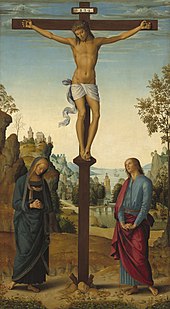
Pietro Perugino’s depiction of the Crucifixion as Stabat
Mater, 1482
Jesus’ crucifixion is described in all four canonical gospels. After the trials,
Jesus makes his way to Calvary by a route known traditionally as the Via
Dolorosa. The three Synoptic Gospels indicate that Simon
of Cyrene assists him, having
been compelled by the Romans to do so. In Luke
23:27–28 Jesus tells the women in
the multitude of people following him not to weep for him but for themselves and
their children. At Calvary Jesus is
offered wine mixed with gall, a concoction usually offered as a painkiller.
Matthew and Mark state that he refuses it.
The soldiers then crucify Jesus and cast lots for his clothes. Above Jesus’ head
on the cross is Pilate’s inscription “Jesus of Nazareth, King of the Jews”, and
the soldiers and passers-by mock him about it. Jesus is crucified between two
convicted thieves, one of whom rebukes Jesus, while the other defends him. The
Roman soldiers break the two thieves’ legs (a procedure designed to hasten death
in a crucifixion), but they do not break those of Jesus, as he is already dead.
One soldier, traditionally identified as Saint
Longinus, pierces Jesus’ side with a lance, and water flows out. In Mark
15:39, impressed by the events, the Roman centurion affirms
that Jesus was the Son of God.
On the same day, Joseph
of Arimathea, with Pilate’s permission and with Nicodemus’
help, removes
Jesus’ body from the cross, wraps him in a clean cloth and buries him in a
new rock-hewn
tomb. In Matthew
27:62–66, on the following day the Jews ask Pilate for the tomb to be sealed
with a stone and placed under guard to ensure the body will remain there.
Resurrection and
ascension
New Testament accounts of Jesus’ resurrection state that on the first day of the
week after the crucifixion (typically interpreted as a Sunday), his tomb is
discovered to be empty and his followers encounter him risen from the dead. His
followers arrive at the tomb early in the morning and meet either one or two
beings (men or angels) dressed in bright robes. Mark
16:9 and John
20:15 indicate that Jesus appears
to Mary
Magdalene first, and Luke
16:9 states that she is one of
themyrrhbearers.
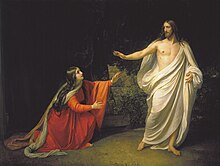
Mary Magdalene’s encounter with Jesus after his resurrection,
depicted byAlexander
Andreyevich Ivanov in
1835
After the discovery of the empty tomb, Jesus makes a series of appearances to
the disciples. These include the Doubting
Thomas episode and the appearance
on the road to Emmaus, where Jesus meets two disciples. The catch
of 153 fish is a miracle by the
Sea of Galilee, after which Jesus encourages Peter to serve his followers.
Before he ascends into heaven, Jesus commissions
his disciples to spread his
teachings to all the nations of the world. Luke
24:51 states that Jesus is then
“carried up into heaven”. The Ascension account is elaborated in Acts
1:1–11 and mentioned 1
Timothy 3:16. In Acts, forty days after the Resurrection, as the disciples
look on, “he was taken up; and a cloud received him out of their sight”. 1
Peter 3:22 describes Jesus as
being on “the right hand of God, having gone into heaven”.
The Acts of the Apostles describe several appearances by Jesus after his
Ascension. Acts
7:55 describes a vision
experienced by Stephen just
before his death. On the road to
Damascus, the Apostle Paul is converted to Christianity after seeing a blinding
light and hearing a voice saying, “I am Jesus whom thou persecutest”. In Acts
9:10–18, Ananias
of Damascus is instructed to heal
Paul. It is the last conversation with Jesus reported in the Bible until the Book
of Revelation, in which a
man named John receives a
revelation from Jesus concerning the end
times.
Jesus of Nazareth (c. 5 BC/BCE – c. 30 AD/CE), also
referred to as Jesus Christ or simply Jesus, is the central figure
of
Christianity. Most
Christian denominations
venerate him as
God the
Son
incarnated
and believe that he
rose from the dead
after being
crucified
.

The
principal sources of information regarding Jesus are the four
canonical gospels, and most
critical scholars
find them, at least the
Synoptic Gospels, useful for reconstructing Jesus’ life and
teachings. Some scholars believe apocryphal texts such as the
Gospel of Thomas and the
Gospel according to the Hebrews
are also
relevant
.
The Byzantine Empire was the predominantly
Greek
-speaking continuation of the
Roman Empire
during
Late Antiquity
and the
Middle Ages
. Its capital city was
Constantinople
(modern-day
Istanbul
), originally known as
Byzantium
. Initially the eastern half of the
Roman Empire (often called the Eastern Roman Empire in this context), it
survived the 5th century
fragmentation and collapse
of the
Western Roman Empire
and continued to thrive,
existing for an additional thousand years until it
fell
to the
Ottoman Turks
in 1453. During most of its
existence, the empire was the most powerful economic, cultural, and military
force in Europe. Both “Byzantine Empire” and “Eastern Roman Empire” are
historiographical terms applied in later centuries; its citizens continued to
refer to their empire as the Roman Empire and Romania .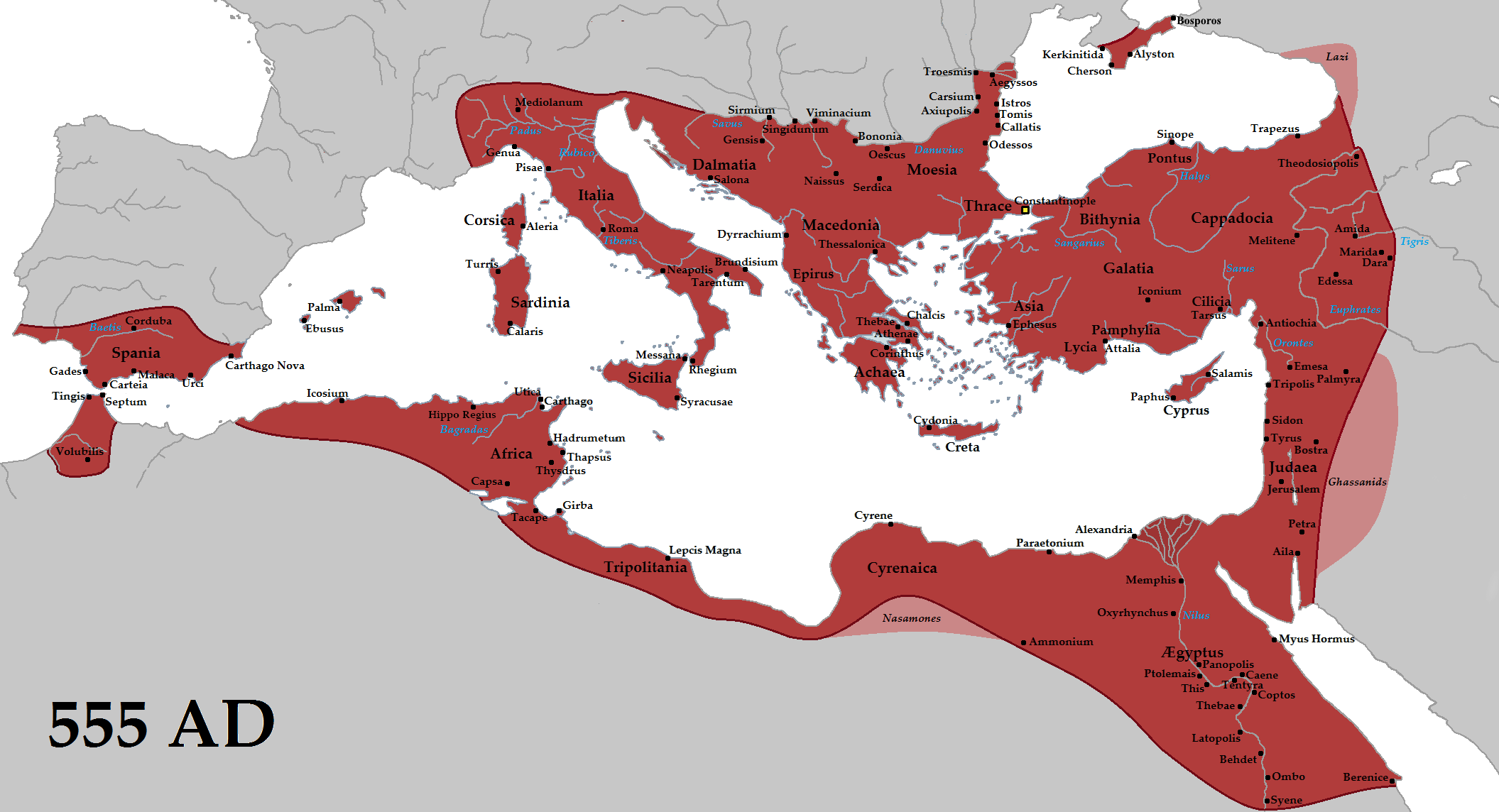
The borders of the Empire evolved a great deal over its existence, as it went
through several cycles of decline and recovery. During the reign of
Justinian I
(r. 527–565), the Empire reached
its greatest extent after reconquering much of the historically Roman western
Mediterranean
coast, including north Africa,
Italy, and Rome itself, which it held for two more centuries. During the reign
of
Maurice
(r. 582–602), the Empire’s eastern
frontier was expanded and the north stabilised. However, his assassination
caused a
two-decade-long war
with
Sassanid Persia
which exhausted the Empire’s
resources and contributed to major territorial losses during the
Muslim conquests
of the 7th century. During the
Macedonian dynasty
(10th-11th centuries), the
Empire again expanded and experienced a two-century long
renaissance
, which came to an end with the loss
of much of Asia Minor to the
Seljuk Turks
after the
Battle of Manzikert
(1071).
The final centuries of the Empire exhibited a general trend of decline. It
struggled to
recover during the 12th century
, but was
delivered a mortal blow during the
Fourth Crusade
, when Constantinople was sacked
and the Empire
dissolved and divided
into competing Byzantine
Greek and
Latin realms
. Despite the eventual recovery of
Constantinople and
re-establishment of the Empire in 1261
,
Byzantium remained only one of several small rival states in the area for the
final two centuries of its existence. This volatile period led to its
progressive annexation by the Ottomans
over the
15th century and the
Fall of Constantinople
in 1453.
Nomenclature
The first use of the term “Byzantine” to label the later years of the
Roman Empire
was in 1557, when the German
historian
Hieronymus Wolf
published his work Corpus
Historiæ Byzantinæ, a collection of historical sources. The term comes from
“Byzantium”, the name of the city of Constantinople before it became
Constantine’s capital. This older name of the city would rarely be used from
this point onward except in historical or poetic contexts. The publication in
1648 of the Byzantine du Louvre (Corpus
Scriptorum Historiae Byzantinae), and in 1680 of
Du Cange
‘s Historia Byzantina further
popularised the use of “Byzantine” among French authors, such as
Montesquieu
. However, it was not until the
mid-19th century that the term came into general use in the Western world. As
regards the English historiography in particular, the first occasion of the
“Byzantine Empire” appears in a 1857 work of
George Finlay
(History of the Byzantine
Empire from 716 to 1057).
The Byzantine Empire was known to its inhabitants as the “Roman Empire”, the
“Empire of the Romans” (Latin: Imperium Romanum, Imperium Romanorum;
Greek: Βασιλεία τῶν Ῥωμαίων Basileia
tōn Rhōmaiōn, Ἀρχὴ τῶν Ῥωμαίων
Archē tōn Rhōmaiōn), “Romania” (Latin: Romania; Greek:
Ῥωμανία Rhōmania), the “Roman
Republic” (Latin: Res Publica Romana; Greek:
Πολιτεία τῶν Ῥωμαίων Politeia tōn
Rhōmaiōn), Graikia (Greek: Γραικία), and also as Rhōmais
(Greek: Ῥωμαΐς).
Although the Byzantine Empire had a multi-ethnic character during most of its
history and preserved
Romano-Hellenistic
traditions, it became
identified by its western and northern contemporaries with its increasingly
predominant
Greek element
. The occasional use of the term
“Empire of the Greeks” (Latin: Imperium Graecorum) in the West to refer
to the Eastern Roman Empire and of the Byzantine Emperor as Imperator
Graecorum (Emperor of the Greeks) were also used to separate it from the
prestige of the Roman Empire within the new kingdoms of the West.
The authority of the Byzantine emperor as the legitimate Roman emperor was
challenged by the coronation of
Charlemagne
as
Imperator Augustus
by
Pope Leo III
in the year 800. Needing
Charlemagne’s support in his struggle against his enemies in Rome, Leo used the
lack of a male occupant of the throne of the Roman Empire at the time to claim
that it was vacant and that he could therefore crown a new Emperor himself.
Whenever the Popes or the rulers of the West made use of the name Roman
to refer to the Eastern Roman Emperors, they usually preferred the term
Imperator Romaniae (meaning Emperor of Romania) instead of
Imperator Romanorum (meaning Emperor of the Romans), a title that
they applied only to Charlemagne and his successors.
No such distinction existed in the Persian, Islamic, and Slavic worlds, where
the Empire was more straightforwardly seen as the continuation of the Roman
Empire.
Early history

The Baptism of Constantine painted by
Raphael
‘s pupils (1520–1524,
fresco
, Vatican City,
Apostolic Palace
).
Eusebius of Caesarea
records that
(as
was common among converts of early
Christianity
) Constantine delayed receiving
baptism
until shortly before his
death.
The Roman army
succeeded in conquering many
territories covering the entire Mediterranean region and coastal regions in
southwestern Europe
and north Africa. These
territories were home to many different cultural groups, ranging from primitive
to highly sophisticated. Generally speaking, the eastern Mediterranean provinces
were more urbanised than the western, having previously been united under the
Macedonian Empire
and
Hellenised
by the influence of Greek culture.
The west also suffered more heavily from the instability of the 3rd century
AD. This distinction between the established Hellenised East and the younger
Latinised West persisted and became increasingly important in later centuries,
leading to a gradual estrangement of the two worlds.
Divisions of
the Roman Empire
In order to maintain control and improve administration, various schemes to
divide the work of the Roman Emperor by sharing it between individuals were
tried between 285 and 324, from 337 to 350, from 364 to 392, and again between
395 and 480. Although the administrative subdivisions varied, they generally
involved a division of labour between East and West. Each division was a form of
power-sharing (or even job-sharing), for the ultimate imperium was not
divisible and therefore the empire remained legally one state—although the
co-emperors often saw each other as rivals or enemies rather than partners.
In 293, emperor
Diocletian
created a new administrative system
(the tetrarchy
), in order to guarantee security in
all endangered regions of his Empire. He associated himself with a co-emperor (Augustus),
and each co-emperor then adopted a young colleague given the title of
Caesar
, to share in their rule and
eventually to succeed the senior partner. The tetrarchy collapsed, however, in
313 and a few years later Constantine I reunited the two administrative
divisions of the Empire as sole Augustus.
Recentralisation
In 330,
Constantine
moved the
seat of the Empire
to
Constantinople
, which he founded as a second
Rome on the site of Byzantium, a city well-positioned astride the trade routes
between East and West. Constantine introduced important changes into the
Empire’s military, monetary, civil and religious institutions. As regards his
economic policies in particular, he has been accused by certain scholars of
“reckless fiscality”, but the gold
solidus
he introduced became a stable currency
that transformed the economy and promoted development.
Under Constantine, Christianity did not become the exclusive religion of the
state, but enjoyed imperial preference, because
the emperor supported it with generous privileges
.
Constantine established the principle that emperors could not settle questions
of doctrine on their own, but should summon instead
general ecclesiastical councils
for that
purpose. His convening of both the
Synod of Arles
and the
First Council of Nicaea
indicated his interest
in the unity of the Church, and showcased his claim to be its head.
In 395,
Theodosius I
bequeathed the imperial office
jointly to his sons:
Arcadius
in the East and
Honorius
in the West, once again dividing
Imperial administration. In the 3rd and 4th centuries, the Eastern part of the
empire was largely spared the difficulties faced by the West—due in part to a
more established urban culture and greater financial resources, which allowed it
to placate invaders with
tribute
and pay foreign mercenaries. This
success allowed
Theodosius II
to focus on the
codification of the Roman law
and the further
fortification of
the walls of Constantinople
, which left the
city impervious to most attacks until 1204.
To fend off the Huns
, Theodosius had to pay an enormous annual
tribute to Attila
. His successor,
Marcian
, refused to continue to pay the
tribute, but Attila had already diverted his attention to the
West
. After his death in 453, the
Hunnic Empire
collapsed, and many of the
remaining Huns were often hired as mercenaries by Constantinople.
Loss of the
western Roman Empire
After the fall of Attila, the Eastern Empire enjoyed a period of peace, while
the Western Empire deteriorated in continuing migration and expansion by
Germanic nations
(its end is usually dated in
476 when the Germanic Roman general
Odoacer
deposed the titular Western Emperor
Romulus Augustulus
). In 480 Emperor
Zeno
abolished the division of the Empire
making himself sole Emperor. Odoacer, now ruler of Italy, was nominally Zeno’s
subordinate but acted with complete autonomy, eventually providing support of a
rebellion against the Emperor.
Zeno negotiated with the invading
Ostrogoths
, who had settled in
Moesia
, convincing the Gothic king
Theodoric
to depart for Italy as magister
militum per Italiam (“commander in chief for Italy”) with the aim to depose
Odoacer. By urging Theodoric into conquering Italy, Zeno rid the Eastern Empire
of an unruly subordinate (Odoacer) and moved another (Theodoric) further from
the heart of the Empire. After Odoacer’s defeat in 493, Theodoric ruled Italy on
his own, although he was never recognised by the eastern emperors as “king” (rex).
In 491,
Anastasius I
, an aged civil officer of Roman
origin, became Emperor, but it was not until 497 that the forces of the new
emperor effectively took the measure of
Isaurian resistance
. Anastasius revealed
himself as an energetic reformer and an able administrator. He perfected
Constantine I’s coinage system by definitively setting the weight of the copper
follis
, the coin used in most everyday
transactions. He also reformed the tax system and permanently abolished the
chrysargyron
tax. The State Treasury contained
the enormous sum of 320,000 lb (150,000 kg) of gold when Anastasius died in 518.
Reconquest of the western provinces
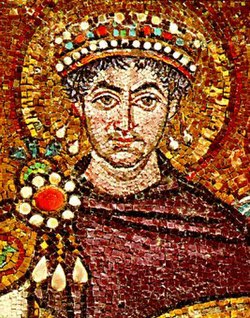
Justinian I
depicted on one of the
famous mosaics of the
Basilica of San Vitale
,
Ravenna
.
Justinian I
, the son of an
Illyrian
peasant, may already have exerted
effective control during the reign of his uncle,
Justin I
(518–527).[32]
He assumed the throne in 527, and oversaw a period of recovery of former
territories. In 532, attempting to secure his eastern frontier, he signed a
peace treaty with
Khosrau I of Persia
agreeing to pay a large
annual tribute to the
Sassanids
. In the same year, he survived a
revolt in Constantinople (the
Nika riots
), which solidified his power but
ended with the deaths of a reported 30,000 to 35,000 rioters on his orders.
In 529, a ten-man commission chaired by
John the Cappadocian
revised the Roman law and
created a new
codification
of laws and jurists’ extracts.
In 534, the Code was updated and, along with the
enactements promulgated by Justinian after 534
,
it formed the system of law used for most of the rest of the Byzantine era.
The western conquests began in 533, as Justinian sent his general
Belisarius
to reclaim the former province of
Africa
from the
Vandals
who had been in control since 429 with
their capital at Carthage. Their success came with surprising ease, but it was
not until 548 that the major local tribes were subdued. In
Ostrogothic Italy
, the deaths of Theodoric, his
nephew and heir
Athalaric
, and his daughter
Amalasuntha
had left her murderer,
Theodahad
(r. 534–536), on the throne despite
his weakened authority.
In 535, a small Byzantine expedition to
Sicily
met with easy success, but the Goths
soon stiffened their resistance, and victory did not come until 540, when
Belisarius captured
Ravenna
, after successful sieges of
Naples
and Rome. In 535–536, Theodahad sent
Pope Agapetus I
to Constantinople to request
the removal of Byzantine forces from Sicily,
Dalmatia
, and Italy. Although Agapetus failed
in his mission to sign a peace with Justinian, he succeeded in having the
Monophysite
Patriarch Anthimus I of Constantinople
denounced, despite empress
Theodora
‘s support and protection.
The Ostrogoths were soon reunited under the command of King
Totila
and
captured Rome
in 546. Belisarius, who had been
sent back to Italy in 544, was eventually recalled to Constantinople in 549. The
arrival of the Armenian eunuch
Narses
in Italy (late 551) with an army of some
35,000 men marked another shift in Gothic fortunes. Totila was defeated at the
Battle of Taginae
and his successor,
Teia, was defeated at the
Battle of Mons Lactarius
(October 552). Despite
continuing resistance from a few Gothic garrisons and two subsequent invasions
by the Franks
and
Alemanni
, the war for the Italian peninsula was
at an end.[40]
In 551, Athanagild
, a noble from
Visigothic
Hispania
, sought Justinian’s help in a
rebellion against the king, and the emperor dispatched a force under
Liberius
, a successful military commander. The
Empire held on to a small slice of the
Iberian Peninsula
coast until the reign of
Heraclius.
In the east, the Roman–Persian Wars continued until 561 when the envoys of
Justinian and Khosrau agreed on a 50-year peace. By the mid-550s, Justinian had
won victories in most theatres of operation, with the notable exception of the
Balkans
, which were subjected to repeated
incursions from the Slavs
and the
Gepids
. Tribes of
Serbs
and
Croats
were later resettled in the northwestern
Balkans, during the reign of Heraclius. Justinian called Belisarius out of
retirement and defeated the new Hunnish threat. The strengthening of the Danube
fleet caused the
Kutrigur
Huns to withdraw and they agreed to a
treaty that allowed safe passage back across the Danube.
During the 6th century, traditional Greco-Roman culture was still influential
in the Eastern empire. Philosophers such as
John Philoponus
drew on
neoplatonic
ideas in addition to Christian
thought and empiricism
. Nevertheless,
Hellenistic philosophy
began to be supplanted
by or amalgamated into newer
Christian philosophy
. Polytheism was
suppressed by the state
. The closure of the
Platonic Academy
was a notable turning point.
Hymns written by
Romanos the Melodist
marked the development of
the Divine Liturgy
, while architects and builders
worked to complete the new Church of the
Holy Wisdom
,
Hagia Sophia
, which was designed to replace an
older church destroyed during the Nika Revolt. The Hagia Sophia stands today as
one of the major monuments of Byzantine architectural history.[45]
During the 6th and 7th centuries, the Empire was struck by a
series of epidemics
, which greatly devastated
the population and contributed to a significant economic decline and a weakening
of the Empire.
After Justinian died in 565, his successor,
Justin II
refused to pay the large tribute to
the Persians. Meanwhile, the Germanic
Lombards
invaded Italy; by the end of the
century only a third of Italy was in Byzantine hands. Justin’s successor,
Tiberius II
, choosing between his enemies,
awarded subsidies to the
Avars
while taking military action against the
Persians. Though Tiberius’ general,
Maurice
, led an effective campaign on the
eastern frontier, subsidies failed to restrain the Avars. They captured the
Balkan fortress of
Sirmium
in 582, while the Slavs began to make
inroads across the Danube.
Maurice, who meanwhile succeeded Tiberius, intervened in a Persian civil war,
placed the legitimate
Khosrau II
back on the throne and married his
daughter to him. Maurice’s treaty with his new brother-in-law enlarged the
territories of the Empire to the East and allowed the energetic Emperor to focus
on the Balkans. By 602, a series of successful Byzantine
campaigns
had pushed the Avars and Slavs back
across the Danube.
Shrinking borders
Heraclian dynasty
After Maurice’s murder by
Phocas
, Khosrau used the pretext to reconquer
the
Roman province of Mesopotamia
. Phocas, an
unpopular ruler invariably described in Byzantine sources as a “tyrant”, was the
target of a number of Senate-led plots. He was eventually deposed in 610 by
Heraclius, who sailed to Constantinople from
Carthage
with an icon affixed to the prow of
his ship.
Following the ascension of Heraclius, the Sassanid advance pushed deep into
Asia Minor, occupying
Damascus
and
Jerusalem
and removing the
True Cross
to
Ctesiphon
. The counter-attack launched by
Heraclius took on the character of a holy war, and an
acheiropoietos
image of Christ was carried as a
military standard[51]
(similarly, when Constantinople was saved from an Avar siege in 626, the victory
was attributed to the icons of the Virgin that were led in procession by
Patriarch Sergius
about the walls of the city).
The main Sassanid force was destroyed at
Nineveh
in 627, and in 629 Heraclius restored
the True Cross to Jerusalem in a majestic ceremony. The war had exhausted both
the Byzantines and Sassanids, however, and left them extremely vulnerable to the
Muslim forces
that emerged in the following
years. The Byzantines suffered a crushing defeat by the Arabs at the
Battle of Yarmouk
in 636, while Ctesiphon fell
in 634.
Siege of Constantinople (674–678)
The Arabs, now firmly in
control of Syria and the Levant
, sent frequent
raiding parties deep into Asia Minor, and in
674–678 laid siege to Constantinople
itself.
The Arab fleet was finally repulsed through the use of
Greek fire
, and a thirty-years’ truce was
signed between the Empire and the
Umayyad Caliphate
. However, the
Anatolian
raids continued unabated, and
accelerated the demise of classical urban culture, with the inhabitants of many
cities either refortifying much smaller areas within the old city walls, or
relocating entirely to nearby fortresses. Constantinople itself dropped
substantially in size, from 500,000 inhabitants to just 40,000–70,000, and, like
other urban centres, it was partly ruralised. The city also lost the free grain
shipments in 618, after Egypt fell first to the Persians and then to the Arabs,
and public wheat distribution ceased.
The void left by the disappearance of the old semi-autonomous civic
institutions was filled by the theme system, which entailed dividing Asia Minor
into “provinces” occupied by distinct armies that assumed civil authority and
answered directly to the imperial administration. This system may have had its
roots in certain ad hoc measures taken by Heraclius, but over the course
of the 7th century it developed into an entirely new system of imperial
governance. The massive cultural and institutional restructuring of the Empire
consequent on the loss of territory in the 7th century has been said to have
caused a decisive break in east Mediterranean Romanness and that the
Byzantine state is subsequently best understood as another successor state
rather than a real continuation of the Roman Empire.
The withdrawal of large numbers of troops from the Balkans to combat the
Persians and then the Arabs in the east opened the door for the gradual
southward expansion of Slavic peoples into the peninsula, and, as in Asia Minor,
many cities shrank to small fortified settlements. In the 670s, the
Bulgars
were pushed south of the Danube by the
arrival of the Khazars
. In 680, Byzantine forces sent to
disperse these new settlements were defeated.
In 681,
Constantine IV
signed a treaty with the Bulgar
khan
Asparukh
, and the
new Bulgarian state
assumed sovereignty over a
number of Slavic tribes that had previously, at least in name, recognised
Byzantine rule. In 687–688, the final Heraclian emperor,
Justinian II
, led an expedition against the
Slavs and Bulgarians, and made significant gains, although the fact that he had
to fight his way from
Thrace
to
Macedonia
demonstrates the degree to which
Byzantine power in the north Balkans had declined.
Justinian II attempted to break the power of the urban aristocracy through
severe taxation and the appointment of “outsiders” to administrative posts. He
was driven from power in 695, and took shelter first with the Khazars and then
with the Bulgarians. In 705, he returned to Constantinople with the armies of
the Bulgarian
khan
Tervel
, retook the throne, and instituted a
reign of terror against his enemies. With his final overthrow in 711, supported
once more by the urban aristocracy, the Heraclian dynasty came to an end.
Isaurian dynasty to the ascension of Basil I
Leo III the Isaurian
turned back the Muslim
assault in 718 and addressed himself to the task of reorganising and
consolidating the themes in Asia Minor. His successor,
Constantine V
, won noteworthy victories in
northern Syria and thoroughly undermined Bulgarian strength.
Taking advantage of the Empire’s weakness after the
Revolt of Thomas the Slav
in the early 820s,
the Arabs reemerged and
captured Crete
. They also successfully attacked
Sicily, but in 863 general
Petronas
gained a
huge victory
against
Umar al-Aqta
, the
emir of
Melitene
. Under the leadership of emperor
Krum, the Bulgarian threat also reemerged, but in 815–816 Krum’s son,
Omurtag
, signed a
peace treaty
with
Leo V
.
Macedonian dynasty and resurgence (867–1025)
The accession of
Basil I
to the throne in 867 marks the
beginning of the
Macedonian dynasty
, which would rule for the
next two and a half centuries. This dynasty included some of the most able
emperors in Byzantium’s history, and the period is one of revival and
resurgence. The Empire moved from defending against external enemies to
reconquest of territories formerly lost.
In addition to a reassertion of Byzantine military power and political
authority, the period under the Macedonian dynasty is characterised by a
cultural revival in spheres such as philosophy and the arts. There was a
conscious effort to restore the brilliance of the period before the
Slavic
and subsequent
Arab invasions
, and the Macedonian era has been
dubbed the “Golden Age” of Byzantium. Though the Empire was significantly
smaller than during the reign of Justinian, it had regained significant
strength, as the remaining territories were less geographically dispersed and
more politically, economically, and culturally integrated.
Wars against the Arabs
In the early years of Basil I’s reign, Arab raids on the coasts of Dalmatia
were successfully repelled, and the region once again came under secure
Byzantine control. This enabled Byzantine missionaries to penetrate to the
interior and convert the Serbs and the principalities of modern-day
Herzegovina
and
Montenegro
to Orthodox Christianity. An attempt
to retake
Malta
ended disastrously, however, when the
local population sided with the Arabs and massacred the Byzantine garrison.
By contrast, the Byzantine position in
Southern Italy
was gradually consolidated so
that by 873 Bari
had once again come under Byzantine rule,
and most of Southern Italy would remain in the Empire for the next 200 years. On
the more important eastern front, the Empire rebuilt its defences and went on
the offensive. The
Paulicians
were defeated and their capital of
Tephrike (Divrigi) taken, while the offensive against the
Abbasid Caliphate
began with the recapture of
Samosata
.
Under Michael’s son and successor,
Leo VI the Wise
, the gains in the east against
the now weak Abbasid Caliphate continued. However, Sicily was lost to the Arabs
in 902, and in 904
Thessaloniki
, the Empire’s second city, was
sacked by an Arab fleet. The weakness of the Empire in the naval sphere was
quickly rectified, so that a few years later a Byzantine fleet had re-occupied
Cyprus
, lost in the 7th century, and also
stormed Laodicea
in Syria. Despite this revenge, the
Byzantines were still unable to strike a decisive blow against the Muslims, who
inflicted a crushing defeat on the imperial forces when they attempted to regain
Crete
in 911.
The death of the Bulgarian tsar
Simeon I
in 927 severely weakened the
Bulgarians, allowing the Byzantines to concentrate on the eastern front.
Melitene was permanently recaptured in 934, and in 943 the famous general
John Kourkouas
continued the offensive in
Mesopotamia
with some noteworthy victories,
culminating in the reconquest of
Edessa
. Kourkouas was especially celebrated for
returning to Constantinople the venerated
Mandylion
, a relic purportedly imprinted with a
portrait of Christ.[75]
The soldier-emperors
Nikephoros II Phokas
(reigned 963–969) and
John I Tzimiskes
(969–976) expanded the empire
well into Syria, defeating the emirs of north-west
Iraq. The great city of
Aleppo
was taken by Nikephoros in 962, and the
Arabs were decisively expelled from Crete in 963. The recapture of Crete put an
end to Arab raids in the Aegean, allowing mainland Greece to flourish once
again. Cyprus
was permanently retaken in 965, and the
successes of Nikephoros culminated in 969 with the recapture of
Antioch
, which he incorporated as a province of
the Empire. His successor John Tzimiskes recaptured Damascus,
Beirut
,
Acre
,
Sidon
,
Caesarea
, and
Tiberias
, putting Byzantine armies within
striking distance of Jerusalem, although the Muslim power centers in Iraq and
Egypt were left untouched. After much campaigning in the north, the last Arab
threat to Byzantium, the rich province of Sicily, was targeted in 1025 by
Basil II
, who died before the expedition could
be completed. Nevertheless, by that time the Empire stretched from the straits
of Messina
to the
Euphrates
and from the Danube to Syria.
Wars
against the Bulgarian Empire
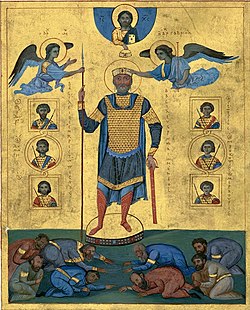
Emperor Basil II (r. 976–1025).
The traditional struggle with the
See of Rome
continued through the Macedonian
period, spurred by the question of religious supremacy over the newly
Christianised state of Bulgaria. Ending eighty years of peace between the two
states, the powerful Bulgarian tsar Simeon I invaded in 894 but was pushed back
by the Byzantines, who used their fleet to sail up the
Black Sea
to attack the Bulgarian rear,
enlisting the support of the
Hungarians
. The Byzantines were defeated at the
Battle of Boulgarophygon
in 896, however, and
agreed to pay annual subsidies to the Bulgarians.
Leo the Wise died in 912, and hostilities soon resumed as Simeon marched to
Constantinople at the head of a large army. Though the walls of the city were
impregnable, the Byzantine administration was in disarray and Simeon was invited
into the city, where he was granted the crown of basileus (emperor) of
Bulgaria and had the young emperor
Constantine VII
marry one of his daughters.
When a revolt in Constantinople halted his dynastic project, he again invaded
Thrace and conquered
Adrianople
. The Empire now faced the problem of
a powerful Christian state within a few days’ marching distance from
Constantinople, as well as having to fight on two fronts.
A great imperial expedition under
Leo Phocas
and
Romanos I Lekapenos
ended with another crushing
Byzantine defeat at the
Battle of Achelous
in 917, and the following
year the Bulgarians were free to ravage northern Greece. Adrianople was
plundered again in 923, and a Bulgarian army laid siege to Constantinople in
924. Simeon died suddenly in 927, however, and Bulgarian power collapsed with
him. Bulgaria and Byzantium entered a long period of peaceful relations, and the
Empire was now free to concentrate on the eastern front against the Muslims. In
968, Bulgaria was overrun by the
Rus’
under
Sviatoslav I of Kiev
, but three years later,
John I Tzimiskes
defeated
the Rus’ and re-incorporated Eastern
Bulgaria into the Byzantine Empire.
Bulgarian resistance revived under the rule of the
Cometopuli dynasty
, but the new emperor Basil
II (r. 976–1025) made the submission of the Bulgarians his primary goal.[84]
Basil’s first expedition against Bulgaria, however, resulted in a humiliating
defeat at the
Gates of Trajan
. For the next few years, the
emperor would be preoccupied with internal revolts in Anatolia, while the
Bulgarians expanded their realm in the Balkans. The war dragged on for nearly
twenty years. The Byzantine victories of
Spercheios
and
Skopje
decisively weakened the Bulgarian army,
and in annual campaigns, Basil methodically reduced the Bulgarian strongholds.[84]
At the
Battle of Kleidion
in 1014 the Bulgarians were
annihilated: their army was captured, and it is said that 99 out of every 100
men were blinded, with the hundredth man left with one eye so he could lead his
compatriots home. When Tsar
Samuil
saw the broken remains of his once
gallant army, he died of shock. By 1018, the last Bulgarian strongholds had
surrendered, and the country became part of the Empire.[84]
This victory restored the Danube frontier, which had not been held since the
days of the emperor Heraclius.[78]
Split between Orthodox Christianity and Catholicism (1054)

Mural of
Saints Cyril and Methodius
, 19th
century,
Troyan Monastery
, Bulgaria.
The Macedonian period also included events of momentous religious
significance. The conversion of the Bulgarians, Serbs and
Rus’
to Orthodox Christianity permanently
changed the religious map of Europe and still resonates today.
Cyril and Methodius
, two
Byzantine Greek
brothers from Thessaloniki,
contributed significantly to the
Christianization of the Slavs
and in the
process devised the
Glagolitic alphabet
, ancestor to the
Cyrillic script
.
In 1054, relations between the Eastern and Western traditions within the
Christian Church reached a terminal crisis, known as the
Great Schism
. Although there was a formal
declaration of institutional separation, on July 16, when three papal legates
entered the Hagia Sophia during Divine Liturgy on a Saturday afternoon and
placed a bull of excommunication on the altar, the so-called Great Schism was
actually the culmination of centuries of gradual separation.
Crisis and
fragmentation
The Empire soon fell into a period of difficulties, caused to a large extent
by the undermining of the theme system and the neglect of the military.
Nikephoros II Phokas
(reigned 963–969), John
Tzimiskes and Basil II changed the military divisions (τάγματα,
tagmata
) from a rapid response, primarily
defensive, citizen army into a professional, campaigning army increasingly
manned by mercenaries.
Mercenaries
, however, were expensive and as the
threat of invasion receded in the 10th century, so did the need for maintaining
large garrisons and expensive fortifications.
Basil II left a burgeoning treasury upon his death, but neglected to plan for
his succession. None of his immediate successors had any particular military or
political skill and the administration of the Empire increasingly fell into the
hands of the civil service. Efforts to revive the Byzantine economy only
resulted in inflation and a debased gold coinage. The army was now seen as both
an unnecessary expense and a political threat. Therefore, native troops were
cashiered and replaced by foreign mercenaries on specific contract.
At the same time, the Empire was faced with new enemies. Provinces in
southern Italy faced the
Normans
, who arrived in Italy at the beginning
of the 11th century. During a period of strife between Constantinople and Rome
that ended in the East-West Schism of 1054, the Normans began to advance, slowly
but steadily, into Byzantine Italy.
Reggio
, the capital of the tagma of Calabria,
was captured in 1060 by
Robert Guiscard
, followed by
Otranto
in 1068. Bari, the main Byzantine
stronghold in Apulia, was besieged in August 1068 and
fell in April 1071
. The Byzantines also lost
their influence over the
Dalmatian
coastal cities to
Peter Krešimir IV of Croatia
(r.
1058–1074/1075) in 1069.
It was in Asia Minor, however, that the greatest disaster would take place.
The Seljuq Turks
made their first explorations
across the Byzantine frontier into Armenia in 1065 and in 1067. The emergency
lent weight to the military aristocracy in Anatolia who, in 1068, secured the
election of one of their own,
Romanos IV Diogenes
, as emperor. In the summer
of 1071, Romanos undertook a massive eastern campaign to draw the Seljuks into a
general engagement with the Byzantine army.
At
Manzikert
, Romanos not only suffered a surprise
defeat at the hands of
Sultan
Alp Arslan
, but was also captured. Alp Arslan
treated him with respect, and imposed no harsh terms on the Byzantines. In
Constantinople, a coup took place in favour of
Michael Doukas
, who soon faced the opposition
of
Nikephoros Bryennios
and
Nikephoros III Botaneiates
. By 1081, the
Seljuks expanded their rule over virtually the entire Anatolian plateau from
Armenia in the east to
Bithynia
in the west and founded their capital
at Nicaea
, just 90 km from Constantinople.
Komnenian
dynasty and the crusaders

Alexios I
, founder of the
Komnenos dynasty
.
The period from about 1081 to about 1185 is often known as the Komnenian or
Comnenian period, after the
Komnenos dynasty
. Together, the five Komnenian
emperors (Alexios I, John II, Manuel I, Alexios II and Andronikos I) ruled for
104 years, presiding over a sustained, though ultimately incomplete, restoration
of the military, territorial, economic and political position of the Byzantine
Empire. Though the Seljuk Turks occupied the Empire’s heartland in Anatolia, it
was against Western powers that most Byzantine military efforts were directed,
particularly the Normans.
The Empire under the Komnenoi played a key role in the history of the
Crusades in the Holy Land, which Alexios I had helped bring about, while also
exerting enormous cultural and political influence in Europe, the Near East, and
the lands around the Mediterranean Sea under John and Manuel. Contact between
Byzantium and the “Latin” West, including the Crusader states, increased
significantly during the Komnenian period. Venetian and other Italian traders
became resident in Constantinople and the empire in large numbers (there were an
estimated 60,000 Latins in Constantinople alone, out of a population of three to
four hundred thousand), and their presence together with the numerous Latin
mercenaries who were employed by Manuel helped to spread Byzantine technology,
art, literature and culture throughout the Latin West, while also leading to a
flow of Western ideas and customs into the Empire.
In terms of prosperity and cultural life, the Komnenian period was one of the
peaks in Byzantine history, and Constantinople remained the leading city of the
Christian world in terms of size, wealth, and culture. There was a renewed
interest in classical Greek philosophy, as well as an increase in literary
output in vernacular Greek. Byzantine art and literature held a pre-eminent
place in Europe, and the cultural impact of Byzantine art on the west during
this period was enormous and of long lasting significance.
Alexios I and
the First Crusade
After Manzikert, a partial recovery (referred to as the Komnenian
restoration) was made possible by the efforts of the Komnenian dynasty. The
first emperor of this dynasty was
Isaac I
(1057–1059) and the second Alexios I.
At the very outset of his reign, Alexios faced a formidable attack by the
Normans under Robert Guiscard and his son
Bohemund of Taranto
, who captured
Dyrrhachium
and
Corfu
, and laid siege to
Larissa
in
Thessaly
. Robert Guiscard’s death in 1085
temporarily eased the Norman problem. The following year, the Seljuq sultan
died, and the sultanate was split by internal rivalries. By his own efforts,
Alexios defeated the
Pechenegs
; they were caught by surprise and
annihilated at the
Battle of Levounion
on 28 April 1091.
Having achieved stability in the West, Alexios could turn his attention to
the severe economic difficulties and the disintegration of the Empire’s
traditional defences. However, he still did not have enough manpower to recover
the lost territories in Asia Minor and to advance against the Seljuks. At the
Council of Piacenza
in 1095, Alexios’ envoys
spoke to
Pope Urban II
about the suffering of the
Christians of the East, and underscored that without help from the West they
would continue to suffer under Muslim rule.
Urban saw Alexios’ request as a dual opportunity to cement Western Europe and
reunite the
Eastern Orthodox Churches
with the
Roman Catholic Church
under his rule. On 27
November 1095, Pope Urban II called together the
Council of Clermont
, and urged all those
present to take up arms under the sign of the
Cross
and launch an armed
pilgrimage
to recover Jerusalem and the East
from the Muslims. The response in Western Europe was overwhelming.
Alexios had anticipated help in the form of mercenary forces from the West,
but was totally unprepared for the immense and undisciplined force that soon
arrived in Byzantine territory. It was no comfort to Alexios to learn that four
of the eight leaders of the main body of the Crusade were Normans, among them
Bohemund. Since the crusade had to pass through Constantinople, however, the
Emperor had some control over it. He required its leaders to swear to restore to
the empire any towns or territories they might conquer from the Turks on their
way to the Holy Land. In return, he gave them guides and a military escort.
Alexios was able to recover a number of important cities and islands, and in
fact much of western Asia Minor. Nevertheless, the crusaders believed their
oaths were invalidated when Alexios did not help them during the siege of
Antioch (he had in fact set out on the road to Antioch, but had been persuaded
to turn back by
Stephen of Blois
, who assured him that all was
lost and that the expedition had already failed). Bohemund, who had set himself
up as
Prince of Antioch
, briefly went to war with the
Byzantines, but agreed to become Alexios’ vassal under the
Treaty of Devol
in 1108, which marked the end
of Norman threat during Alexios’ reign.
John II, Manuel I and the Second Crusade
Alexios’s son
John II Komnenos
succeeded him in 1118, and
ruled until 1143. John was a pious and dedicated Emperor who was determined to
undo the damage his empire had suffered at the Battle of Manzikert, half a
century earlier. Famed for his piety and his remarkably mild and just reign,
John was an exceptional example of a moral ruler, at a time when cruelty was the
norm. For this reason, he has been called the Byzantine
Marcus Aurelius
.
In the course of his twenty-five year reign, John made alliances with the
Holy Roman Empire
in the West, decisively
defeated the Pechenegs at the
Battle of Beroia
, and personally led numerous
campaigns against the
Turks
in Asia Minor. John’s campaigns
fundamentally changed the balance of power in the East, forcing the Turks onto
the defensive and restoring to the Byzantines many towns, fortresses and cities
right across the peninsula. He also thwarted Hungarian, and Serbian threats
during the 1120s, and in 1130 allied himself with the
German emperor
Lothair III
against the Norman king
Roger II of Sicily
.
In the later part of his reign, John focused his activities on the East. He
defeated the
Danishmend
emirate of
Melitene
, and reconquered all of
Cilicia
, while forcing
Raymond of Poitiers
, Prince of Antioch, to
recognise Byzantine suzerainty. In an effort to demonstrate the Emperor’s role
as the leader of the Christian world, John marched into the
Holy Land
at the head of the combined forces of
the Empire and the
Crusader states
; yet despite the great vigour
with which he pressed the campaign, John’s hopes were disappointed by the
treachery of his Crusader allies.In 1142, John returned to press his claims to
Antioch, but he died in the spring of 1143 following a hunting accident. Raymond
was emboldened to invade Cilicia, but he was defeated and forced to go to
Constantinople to beg mercy from the new Emperor.
John’s chosen heir was his fourth son,
Manuel I Komnenos
, who campaigned aggressively
against his neighbours both in the west and in the east. In Palestine, he allied
himself with the Crusader
Kingdom of Jerusalem
and sent a large fleet to
participate in a combined invasion of
Fatimid Egypt
. Manuel reinforced his position
as overlord of the Crusader states, with his hegemony over Antioch and Jerusalem
secured by agreement with
Raynald
, Prince of Antioch, and
Amalric
, King of Jerusalem respectively.
In an effort to restore Byzantine control over the ports of southern Italy,
he sent an expedition to Italy in 1155, but disputes within the coalition led to
the eventual failure of the campaign. Despite this military setback, Manuel’s
armies successfully invaded the
Kingdom of Hungary
in 1167, defeating the
Hungarians at the
Battle of Sirmium
. By 1168, nearly the whole of
the eastern Adriatic coast lay in Manuel’s hands. Manuel made several alliances
with the Pope and Western Christian kingdoms, and successfully handled the
passage of the
Second Crusade
through his empire.
In the east, Manuel suffered a major defeat at the
Battle of Myriokephalon
, in 1176, against the
Turks. Yet the losses were quickly made good, and in the following year Manuel’s
forces inflicted a defeat upon a force of “picked Turks”. The Byzantine
commander John Vatatzes, who destroyed the Turkish invaders at the
Battle of Hyelion and Leimocheir
, not only
brought troops from the capital but also was able to gather an army along the
way; a sign that the Byzantine army remained strong and that the defensive
program of western Asia Minor was still successful.
12th-century
Renaissance
John and Manuel pursued active military policies, and both deployed
considerable resources on sieges and on city defences; aggressive fortification
policies were at the heart of their imperial military policies.[126]
Despite the defeat at Myriokephalon, the policies of Alexios, John and Manuel
resulted in vast territorial gains, increased frontier stability in Asia Minor,
and secured the stabilisation of the Empire’s European frontiers. From circa
1081 to circa 1180, the Komnenian army assured the Empire’s security, enabling
Byzantine civilisation to flourish.
This allowed the Western provinces to achieve an economic revival that
continued until the close of the century. It has been argued that Byzantium
under the Komnenian rule was more prosperous than at any time since the Persian
invasions of the 7th century. During the 12th century, population levels rose
and extensive tracts of new agricultural land were brought into production.
Archaeological evidence from both Europe and Asia Minor shows a considerable
increase in the size of urban settlements, together with a notable upsurge in
new towns. Trade was also flourishing; the Venetians, the
Genoese
and others opened up the ports of the
Aegean to commerce, shipping goods from the Crusader kingdoms of
Outremer
and Fatimid Egypt to the west and
trading with the Empire via Constantinople.
Decline and
disintegration
Dynasty of the Angeloi
Manuel’s death on 24 September 1180 left his 11-year-old son
Alexios II Komnenos
on the throne. Alexios was
highly incompetent at the office, but it was his mother,
Maria of Antioch
, and her Frankish background
that made his regency unpopular. Eventually,
Andronikos I Komnenos
, a grandson of Alexios I,
launched a revolt against his younger relative and managed to overthrow him in a
violent coup d’état.
Utilizing his good looks and his immense popularity with the army, he marched
on to Constantinople in August 1182,
and incited a massacre of the Latins
. After
eliminating his potential rivals, he had himself crowned as co-emperor in
September 1183. He eliminated Alexios II, and took his 12-year-old wife
Agnes of France
for himself.
Andronikos began his reign well; in particular, the measures he took to
reform the government of the Empire have been praised by historians. According
to
George Ostrogorsky
, Andronikos was determined
to root out corruption: Under his rule, the sale of offices ceased; selection
was based on merit, rather than favouritism; officials were paid an adequate
salary so as to reduce the temptation of bribery. In the provinces, Andronikos’s
reforms produced a speedy and marked improvement.
Fourth Crusade
In 1198,
Pope Innocent III
broached the subject of a new
crusade through
legates
and
encyclical letters
. The stated intent of the
crusade was to conquer
Egypt
, now the centre of Muslim power in the
Levant
. The crusader army that arrived at
Venice
in the summer of 1202 was somewhat
smaller than had been anticipated, and there were not sufficient funds to pay
the Venetians, whose fleet was hired by the crusaders to take them to Egypt.
Venetian policy under the ageing and blind but still ambitious
Doge
Enrico Dandolo
was potentially at variance with
that of the Pope and the crusaders, because Venice was closely related
commercially with Egypt.
The crusaders accepted the suggestion that in lieu of payment they assist the
Venetians in the capture of the (Christian) port of
Zara
in Dalmatia (vassal city of Venice, which
had rebelled and placed itself under Hungary’s protection in 1186). The city
fell in November 1202 after a brief
siege
. Innocent, who was informed of the plan
but his veto disregarded, was reluctant to jeopardise the Crusade, and gave
conditional absolution to the crusaders—not, however, to the Venetians.
Crusader sack of Constantinople (1204)
The crusaders arrived at the city in the summer of 1203 and quickly attacked,
started a major fire that damaged large parts of the city, and seized control of
it (first of two times). Alexios III fled from the capital, and Alexios Angelos
was elevated to the throne as Alexios IV along with his blind father Isaac.
However, Alexios IV and Isaac II were unable to keep their promises and were
deposed by Alexios V. Eventually, the crusaders took the city a second time on
13 April 1204 and Constantinople was subjected to pillage and massacre by the
rank and file for three days.
Many priceless icons, relics, and other objects later turned up in Western
Europe, a large number in Venice. According to Choniates, a prostitute was even
set up on the Patriarchal throne. When Innocent III heard of the conduct of his
crusaders, he castigated them in no uncertain terms. But the situation was
beyond his control, especially after his legate, on his own initiative, had
absolved the crusaders from their vow to proceed to the Holy Land.
When order had been restored, the crusaders and the Venetians proceeded to
implement their agreement;
Baldwin of Flanders
was elected
Emperor
and the Venetian
Thomas Morosini
chosen as Patriarch. The lands
divided up among the leaders included most of the former Byzantine possessions,
however resistance would continue through the Byzantine remnants of the
Nicaea
,
Trebizond
, and
Epirus
.
Fall
Empire in exile
After the sack of Constantinople in 1204 by Latin crusaders, two Byzantine
successor states were established: the Empire of Nicaea, and the Despotate of
Epirus. A third one, the Empire of Trebizond was created a few weeks before the
sack of Constantinople by
Alexios I of Trebizond
. Of these three
successor states, Epirus and Nicaea stood the best chance of reclaiming
Constantinople. The Nicaean Empire struggled, however, to survive the next few
decades, and by the mid-13th century it lost much of southern Anatolia.
The weakening of the
Sultanate of Rûm
following the
Mongol Invasion in 1242–43
allowed many
beyliks
and
ghazis
to set up their own principalities in
Anatolia, weakening the Byzantine hold on Asia Minor. In time, one of the Beys,
Osman I
, created an empire that would
eventually conquer Constantinople. However, the Mongol Invasion also gave Nicaea
a temporary respite from Seljuk attacks allowing it to concentrate on the Latin
Empire only north of its position.
Reconquest of
Constantinople
The Empire of Nicaea, founded by the
Laskarid dynasty
, managed to
reclaim Constantinople
from the Latins in 1261
and defeat Epirus. This led to a short-lived revival of Byzantine fortunes under
Michael VIII Palaiologos
, but the war-ravaged
Empire was ill-equipped to deal with the enemies that now surrounded it. To
maintain his campaigns against the Latins, Michael pulled troops from Asia
Minor, and levied crippling taxes on the peasantry, causing much resentment.
Massive construction projects were completed in Constantinople to repair the
damages of the Fourth Crusade, but none of these initiatives was of any comfort
to the farmers in Asia Minor, suffering raids from Muslim ghazis.
Rather than holding on to his possessions in Asia Minor, Michael chose to
expand the Empire, gaining only short-term success. To avoid another sacking of
the capital by the Latins, he forced the Church to submit to Rome, again a
temporary solution for which the peasantry hated Michael and Constantinople. The
efforts of
Andronikos II
and later his grandson
Andronikos III
marked Byzantium’s last genuine
attempts in restoring the glory of the Empire. However, the use of mercenaries
by Andronikos II would often backfire, with the
Catalan Company
ravaging the countryside and
increasing resentment towards Constantinople.
Rise of the Ottomans and fall of Constantinople
Things went worse for Byzantium during the civil wars that followed after
Andronikos III died. A
six-year long civil war
devastated the empire,
allowing the Serbian ruler
Stefan IV Dushan
(r. 1331–1346) to overrun most
of the Empire’s remaining territory and establish a short-lived “Serbian
Empire“. In 1354, an earthquake at
Gallipoli
devastated the fort, allowing the
Ottomans
(who were hired as mercenaries during
the civil war by
John VI Kantakouzenos
) to establish themselves
in Europe. By the time the Byzantine civil wars had ended, the Ottomans had
defeated the Serbians and subjugated them as vassals. Following the
Battle of Kosovo
, much of the Balkans became
dominated by the Ottomans.
The Byzantine emperors appealed to the West for help, but the Pope would only
consider sending aid in return for a reunion of the Eastern Orthodox Church with
the See of Rome. Church unity was considered, and occasionally accomplished by
imperial decree, but the Orthodox citizenry and clergy intensely resented the
authority of Rome and the
Latin Rite
. Some Western troops arrived to
bolster the Christian defence of Constantinople, but most Western rulers,
distracted by their own affairs, did nothing as the Ottomans picked apart the
remaining Byzantine territories.
Constantinople by this stage was underpopulated and dilapidated. The
population of the city had collapsed so severely that it was now little more
than a cluster of villages separated by fields. On 2 April 1453,
Sultan Mehmed
‘s army of some 80,000 men and
large numbers of irregulars laid siege to the city.
Despite a desperate last-ditch defence of the city by the massively
outnumbered Christian forces (c. 7,000 men, 2,000 of whom were foreign),[153]
Constantinople finally fell to the Ottomans after a two-month siege on 29 May
1453. The last Byzantine Emperor,
Constantine XI Palaiologos
, was last seen
casting off his imperial regalia and throwing himself into hand-to-hand combat
after the walls of the city were taken.[155]
Religion
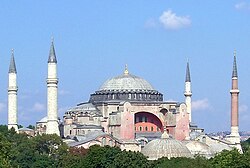
As a symbol and expression of the universal prestige of the
Patriarchate of Constantinople, Justinian built the Church of the
Holy Wisdom of God, Hagia Sophia, which was completed in the short
period of four and a half years (532–537).
The survival of the Empire in the East assured an active role of the Emperor
in the affairs of the Church. The Byzantine state inherited from pagan times the
administrative, and financial routine of administering religious affairs, and
this routine was applied to the
Christian Church
. Following the pattern set by
Eusebius of Caesarea
, the Byzantines viewed the
Emperor as a representative or messenger of
Christ
, responsible particularly for the
propagation of Christianity among pagans, and for the “externals” of the
religion, such as administration and finances. As
Cyril Mango
points out, the Byzantine political
thinking can be summarised in the motto “One God, one empire, one religion”.
The official state Christian doctrine was determined by the
first seven ecumenical councils
, and it was
then the emperor’s duty to impose it to his subjects. An imperial decree of 388,
which was later incorporated into the Codex Justinianus, orders the
population of the Empire “to assume the name of Catholic Christians”, and
regards all those who will not abide by the law as “mad and foolish persons”; as
followers of “heretical dogmas”.[175]
Despite imperial decrees and the stringent stance of the
state church
itself, which came to be known as
the
Eastern Orthodox Church
or
Eastern Christianity
, the latter never
represented all Christians in Byzantium. Mango believes that, in the early
stages of the Empire, the “mad and foolish persons”, those labelled “heretics”
by the state church, were the majority of the population.[176]
Besides the pagans
, who existed until the end of the 6th
century, and the
Jews
, there were many followers – sometimes
even emperors – of various Christian doctrines, such as
Nestorianism
,
Monophysitism
,
Arianism
, and
Paulicianism
, whose teachings were in some
opposition to the main theological doctrine, as determined by the Ecumenical
Councils.[177]
Another division among Christians occurred, when Leo III ordered the
destruction of icons throughout the Empire. This led to a
significant religious crisis
, which ended in
mid-9th century with the restoration of icons. During the same period, a new
wave of pagans emerged in the Balkans, originating mainly from Slavic people.
These were gradually
Christianised
, and by Byzantium’s late stages,
Eastern Orthodoxy represented most Christians and, in general, most people in
what remained of the Empire.
Jews were a significant minority in the Byzantine state throughout its
history, and, according to Roman law, they constituted a legally recognised
religious group. In the early Byzantine period they were generally tolerated,
but then periods of tensions and persecutions ensued. In any case, after the
Arab conquests, the majority of Jews found themselves outside the Empire; those
left inside the Byzantine borders apparently lived in relative peace from the
10th century onwards.
Legacy

King David
in robes of a Byzantine
emperor. Miniature from the
Paris Psalter
.
Byzantium has been often identified with absolutism, orthodox spirituality,
orientalism and exoticism, while the terms “Byzantine” and “Byzantinism” have
been used as bywords for decadence, complex bureaucracy, and repression. In the
countries of
Central
and Southeast Europe that exited the
Eastern Bloc
in late 80s and early 90s, the
assessment of Byzantine civilisation and its legacy was strongly negative due to
their connection with an alleged “Eastern authoritarianism and autocracy.” Both
Eastern and Western European authors have often perceived Byzantium as a body of
religious, political, and philosophical ideas contrary to those of the West.
Even in
19th-century Greece
, the focus was mainly on
the classical past, while Byzantine tradition had been associated with negative
connotations.
This traditional approach towards Byzantium has been partially or wholly
disputed and revised by modern studies, which focus on the positive aspects of
Byzantine culture and legacy.
Averil Cameron
regards as undeniable the
Byzantine contribution to the formation of the medieval Europe, and both Cameron
and Obolensky recognise the major role of Byzantium in shaping Orthodoxy, which
in turn occupies a central position in the history and societies of Greece,
Bulgaria, Russia, Serbia and other countries.[208]
The Byzantines also preserved and copied classical manuscripts, and they are
thus regarded as transmitters of the classical knowledge, as important
contributors to the modern European civilisation, and as precursors of both the
Renaissance humanism
and the Slav Orthodox
culture.
As the only stable long-term state in Europe during the Middle Ages,
Byzantium isolated Western Europe from newly emerging forces to the East.
Constantly under attack, it distanced Western Europe from Persians, Arabs,
Seljuk Turks, and for a time, the Ottomans. From a different perspective, since
the 7th century, the evolution and constant reshaping of the Byzantine state
were directly related to the respective progress of Islam.
Following the conquest of Constantinople by the Ottoman Turks in 1453, Sultan
Mehmed II
took the title “Kaysar-i-Rûm”
(the Turkish equivalent of Caesar of Rome), since he was determined to make the
Ottoman Empire the heir of the Eastern Roman Empire. According to Cameron,
regarding themselves as “heirs” of Byzantium, the Ottomans preserved important
aspects of its tradition, which in turn facilitated an “Orthodox revival” during
the post-communist
period of the Eastern European
states.
|






 Michael
Michael 





















